Ayutthaya – Thailand’s Forgotten Capital
This is my fourth post from Thailand which Alison and I visited on two occasions in early 2023. In the last post we ventured out of Bangkok to visit the celebrated Bridge on the River Kwai and the museum associated with the Death Railway. In this post we’ll also leave Bangkok and head up the Chao Praya river to Ayutthaya which was the capital of the Kingdom of Siam from the 14th to the 18th century. It was completely destroyed by an invading Burmese army in 1767 and never rebuilt. What remains today is a set of magnificent ruins that have been designated as a UNESCO World Heritage Site. Please join us as we not only visit the site of Ayutthaya, but also take a boat ride to see the ruins from the water as well.
History of Ayutthaya
The Thai aka Tai people were relative late comers to southeast Asia, migrating into the region between the 8th and 10th centuries from China. It took several hundred years for a number of disparate Thai fiefdoms all centred around the lower Chao Praya River to unite into one, which they named Ayutthaya.
This is a map of Southeast Asia from 1707 showing the eight kingdoms that then governed the area with Ayutthaya occupying an area that with the exception of northern Thailand, largely corresponds to the modern boundaries of that country. During this trip to Southeast Asia Alison and I will visit all of these, but Lan Na.
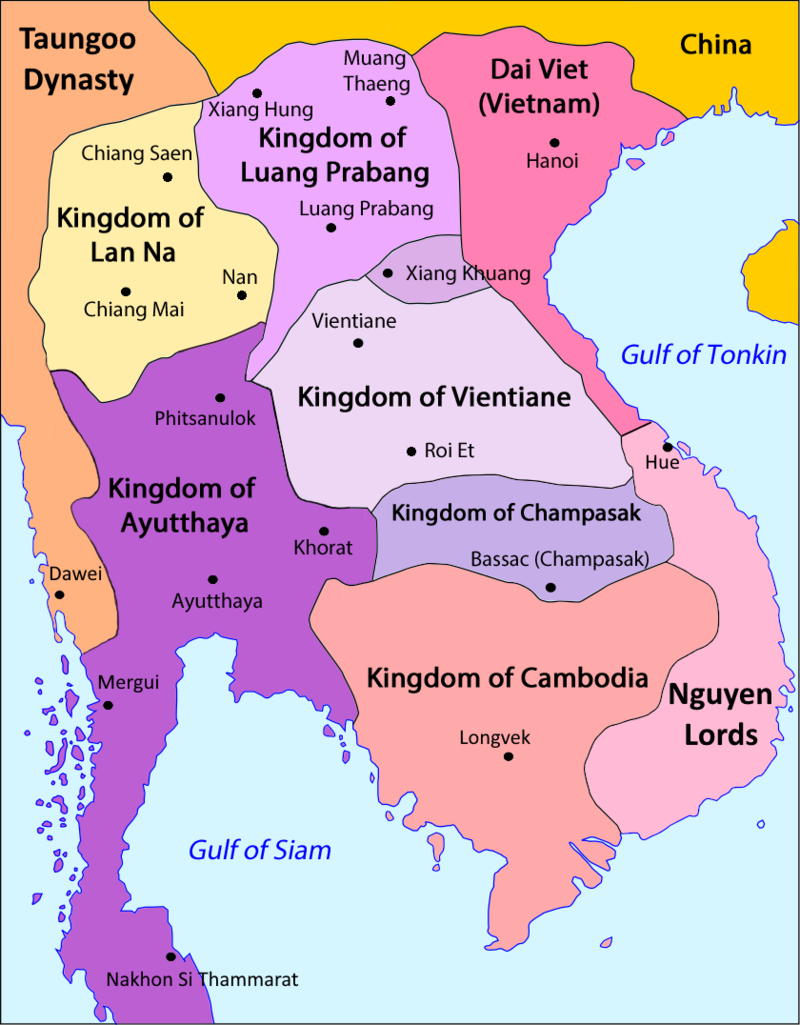
The city of Ayutthaya was nominally founded in 1351 by one King Uthong, but archaeological finds on site indicate an earlier date. Originally the Ayutthaya kingdom was largely maritime and the city was a port, much like Bangkok is today. However, it gradually acquired more lands to the north through aggressive warfare and by the 18th century its boundaries were as shown in the map above. As the kingdom grew in stature and wealth so did the city. The first Europeans to visit were the Portuguese in the early 1500’s, but incredibly Ayutthaya appears on a 1450 map of the world by Fra Mauro, a Venetian cartographer, so its fame was such that it was known in Europe long before any European had actually seen it.
Between 1547 and 1767 Ayutthaya engaged in a series of wars with the Taungoo Dynasty of neighbouring Burma. Both sides had periods of dominance, but ultimately in 1767, after a 14 month siege, the city was sacked and burned with only a few buildings being left undisturbed. As we found out on our visit to the Grand Palace at Bangkok it was the destruction of Ayutthaya that led to the relocation of the capital to newly founded city further down the river. Adding insult to injury, much of what remained of Ayutthaya was demolished to be used as building material for the new capital.
It was only in the late 1960’s that any serious restoration work was undertaken and those efforts continue to the present day.
Below is a map of Ayutthaya which includes the Historical Park which coincides with the UNESCO World Heritage Site. However, the entire island upon which Ayutthaya was built contains many additional historic sites outside the park boundaries. Eventually the plan is for all the island to be incorporated into the World Heritage Site.
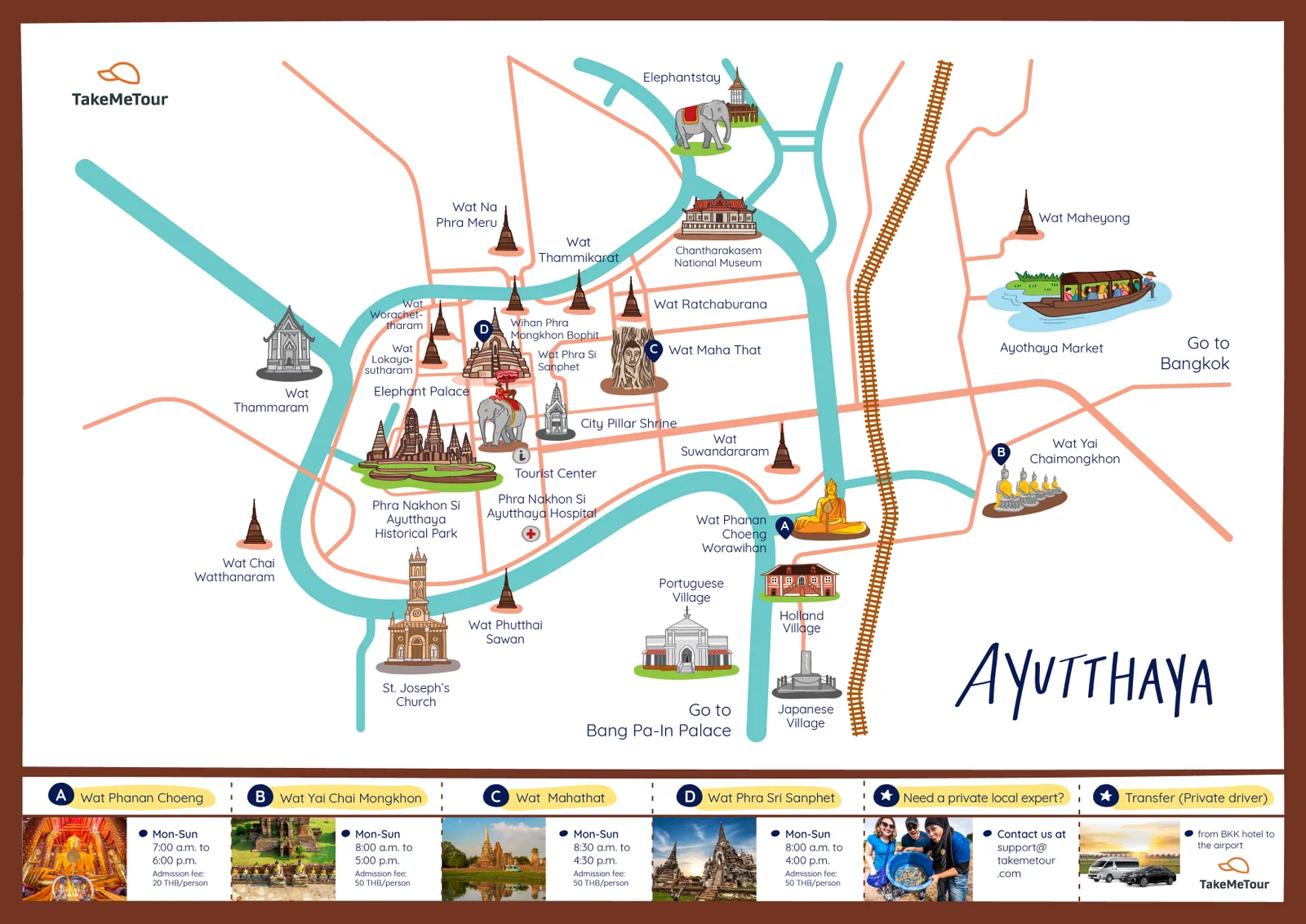
The drive from our hotel, the Mandarin Oriental to Ayutthaya takes about 90 minutes and we arrive with our guide Su from Trails of Indochina almost at the 9:00 AM opening time. Getting to places like this before the big bus tours arrive is essential to having a more enjoyable experience.
The site is far too large to see everything in one visit and also without a wide angle lens impossible to capture the grandeur of the place with one photograph. The best place to get something halfway decent is from the river where I took this photo after our visit. This is Wat Chaiwatthanaram which is actually not in the Historic Park. but on the island of Ayutthaya nonetheless and in my opinion the best exemplar of the destroyed city.
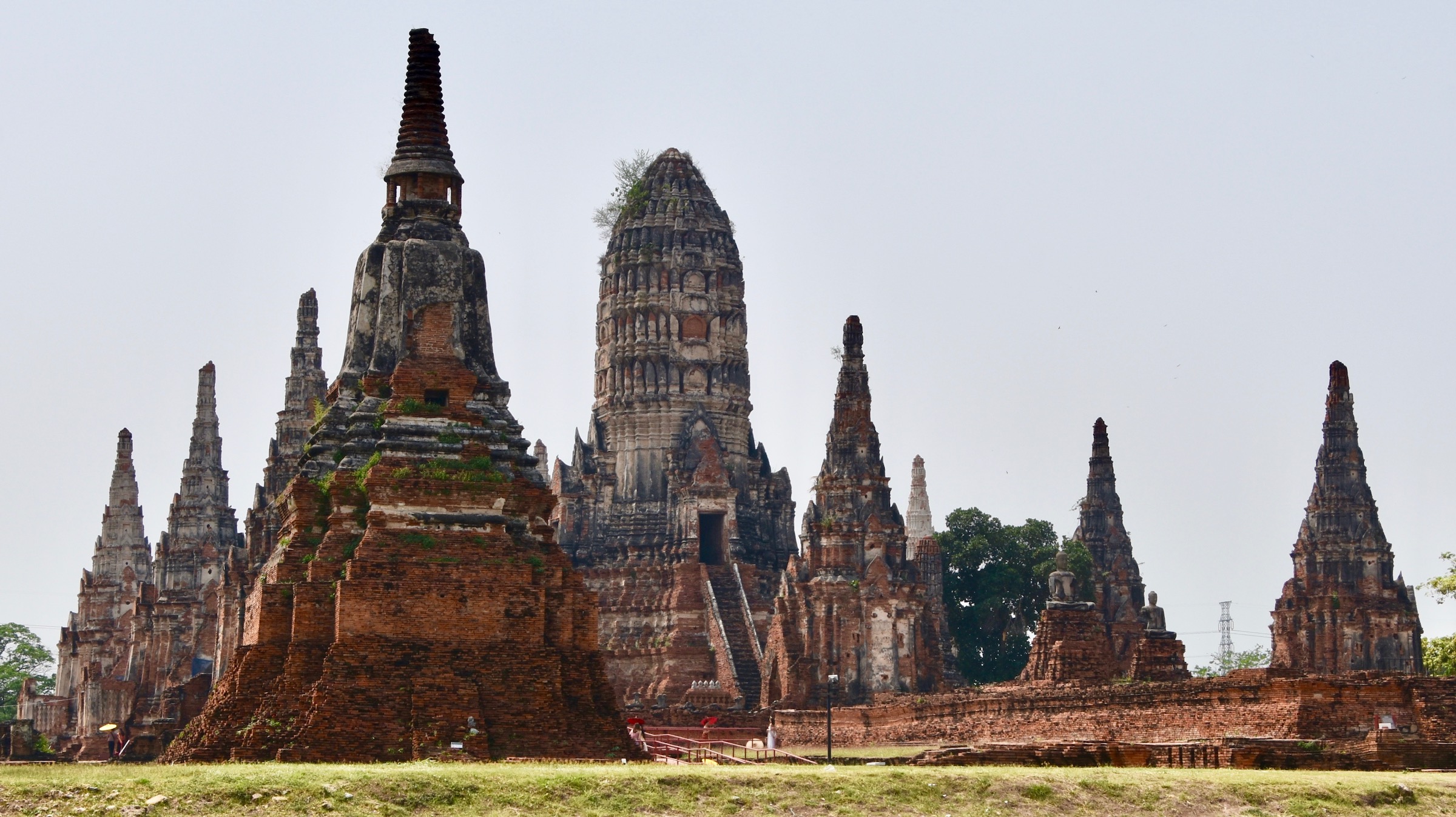
In the meantime I’ll do my best to show you around.
This is a model of what the Grand Palace complex would have looked like before it was pillaged and burnt.
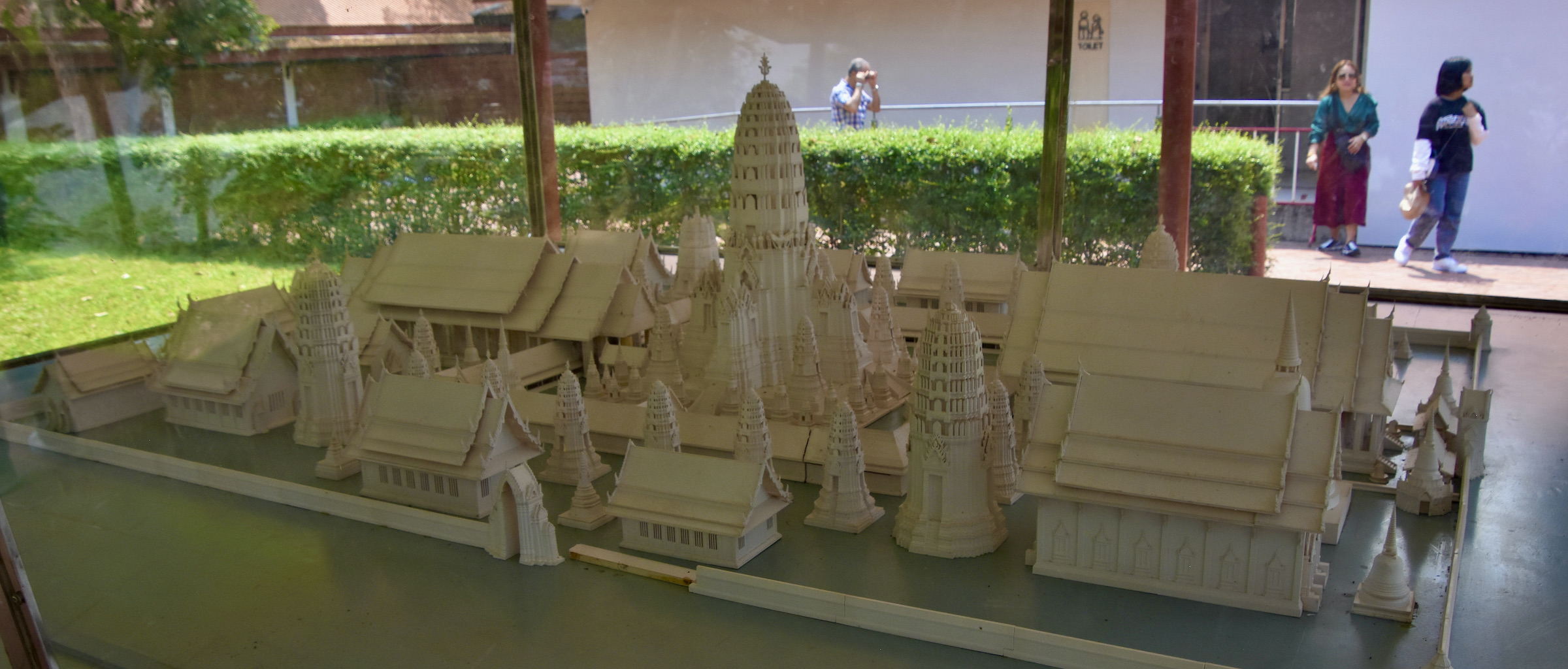
This is all that is left today. The basic building material was red brick, but having seen the Royal Palace in Bangkok it’s not hard to imagine how splendid this once must have been, covered in gold and ornately painted designs.
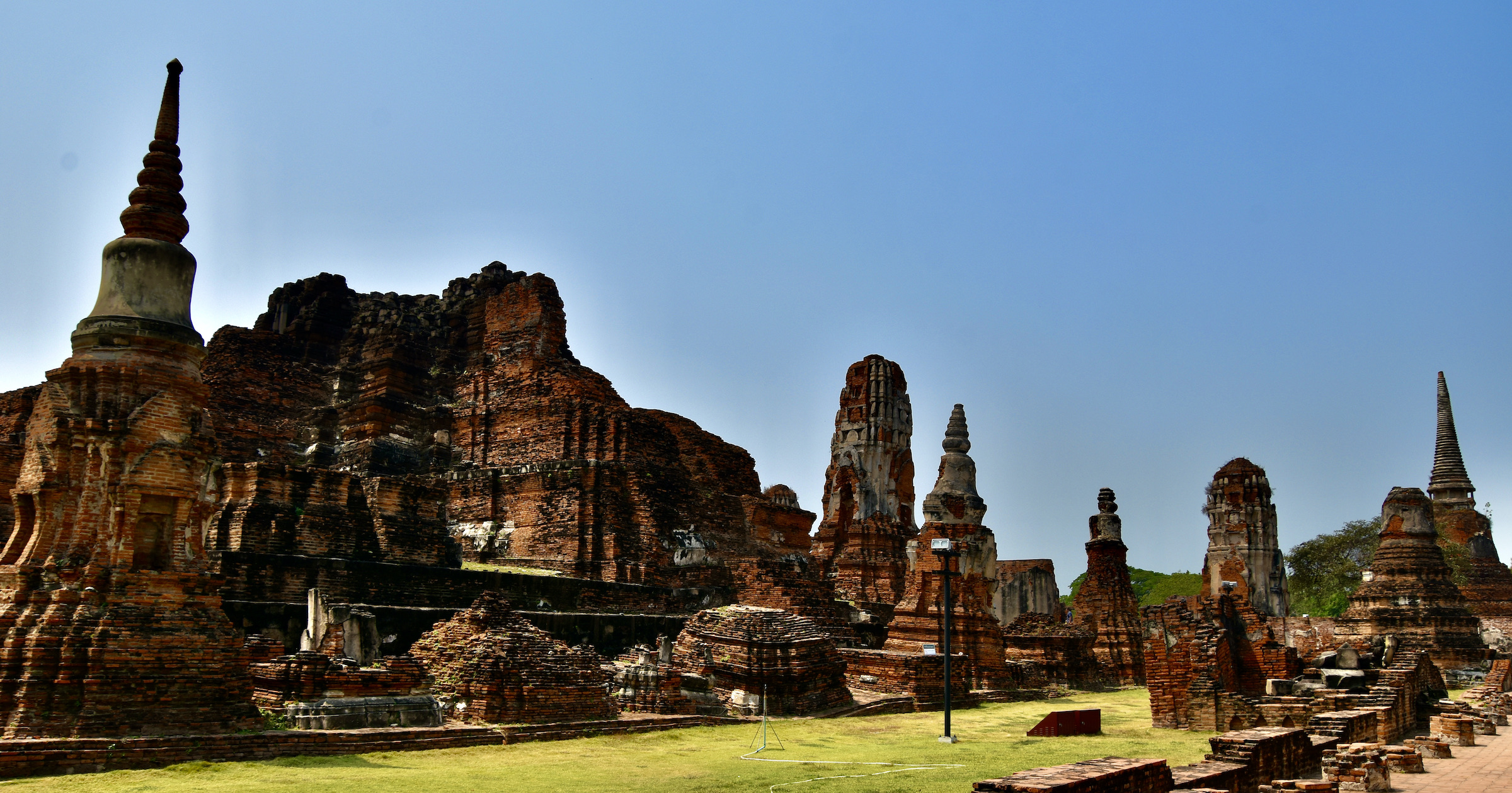
This is Wat Mahathat or the Octagonal Pagoda, built in 1374 by King Boromma Rachathirat I to house relics of the Buddha. Wat is simply another word for temple and we will be seeing it a lot on this trip. Most people associate the word with Khmer architecture, in particular Angkor Wat which we will also visit on this trip. This wat was definitely inspired by Khmer architecture and in its glory days would have resembled one of the temple towers of Angkor Wat.
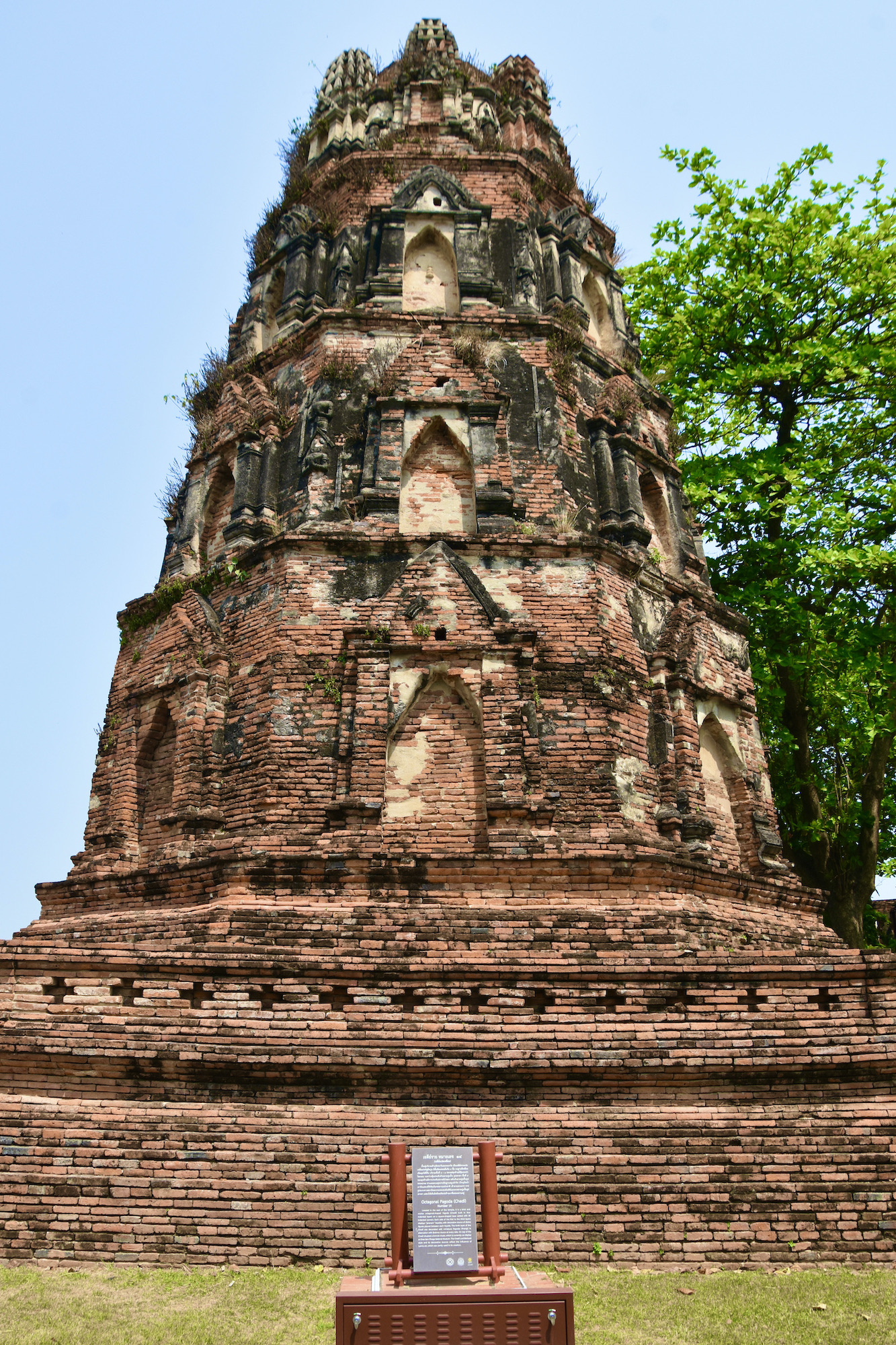
Even if you have never heard of Ayutthaya you are probably familiar with the subject of the next photo. It is simply awesome to see in person and something right out of Ripley’s Believe it or Not.
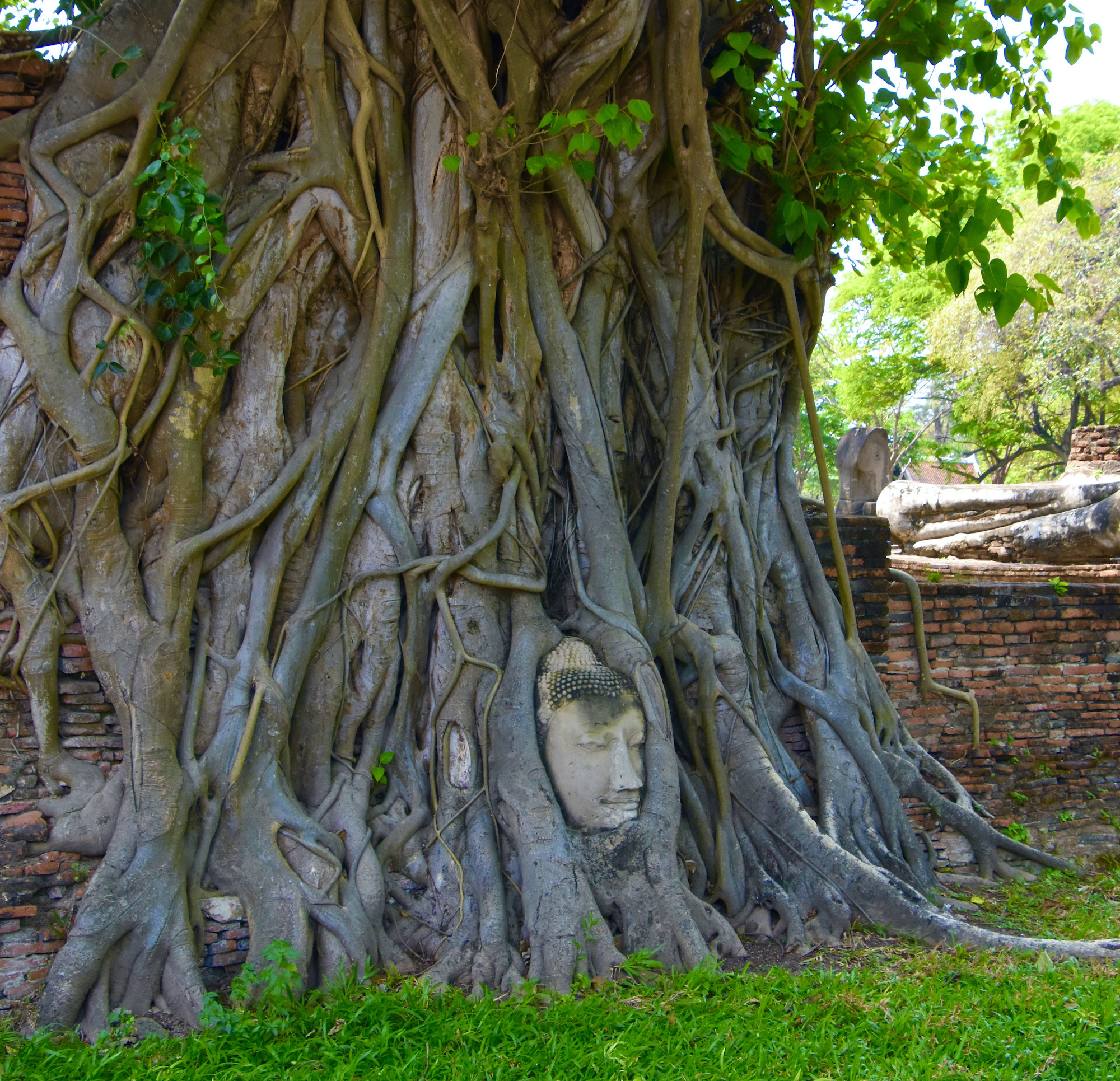
No one knows how or why the Buddha head became enveloped by the roots of the banyan tree, but the serene look on the face creates an aura of benignity that makes you sense that what is happening here is not malevolent. Buddha is not being swallowed up, but rather is in a place of secure peace. I saw a lot of wondrous things on this Southeast Asia trip and this was definitely near the top of the list. It was especially nice to see it without a horde of other tourists, because on your own you can better appreciate the power of this image.
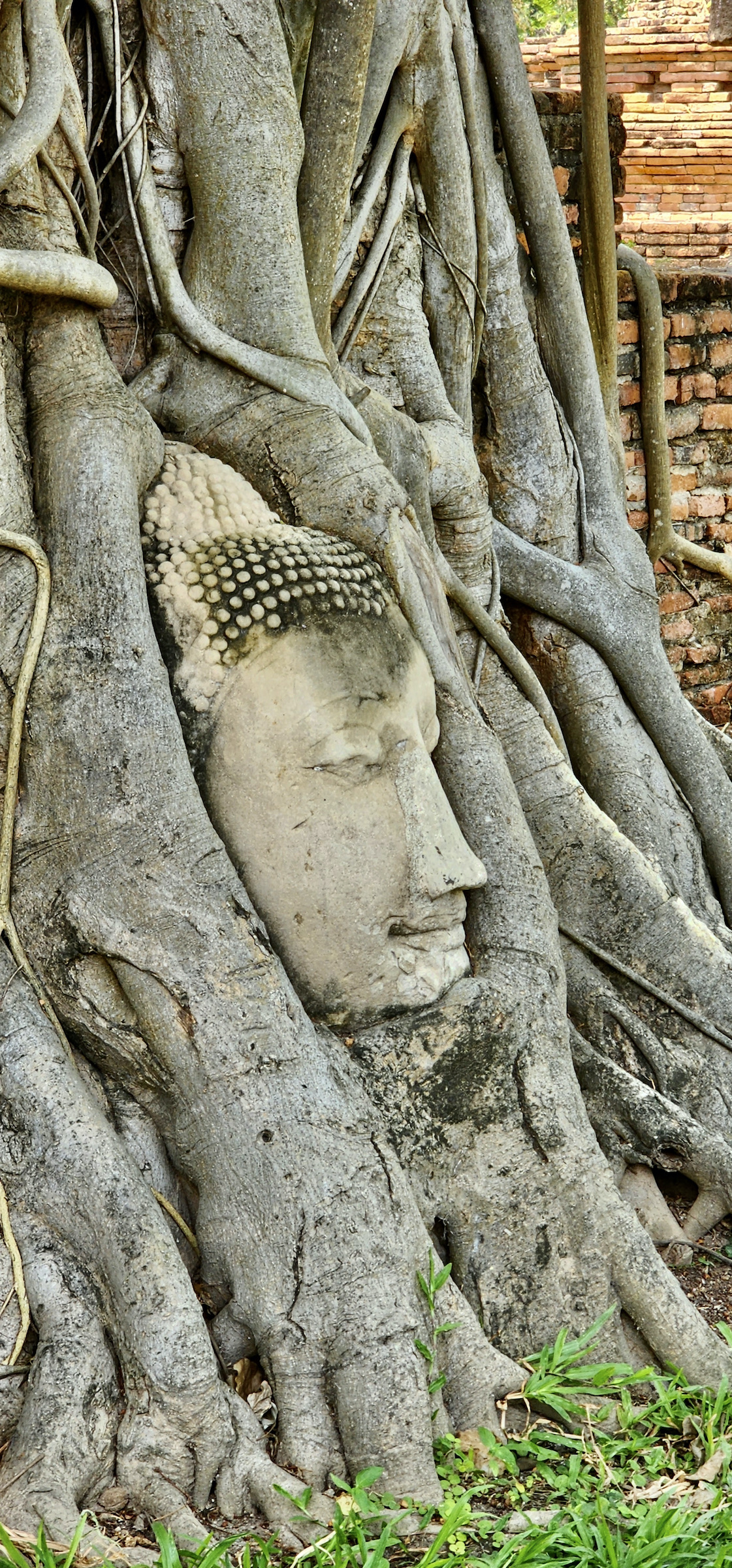
This is a smaller wat that is part of the Wat Mahathat complex with a sitting Buddha statue relatively intact. My education in Buddhism got underway in Bangkok and now continues at Ayutthaya. There are 12 different poses in which you might find a statue of Buddha and they all have different meanings. This sitting pose with one palm flat and the other pointing outward is known as the Earth Buddha and is a reference to his successful resistance to the temptations of the demon Mara and eventual enlightenment.
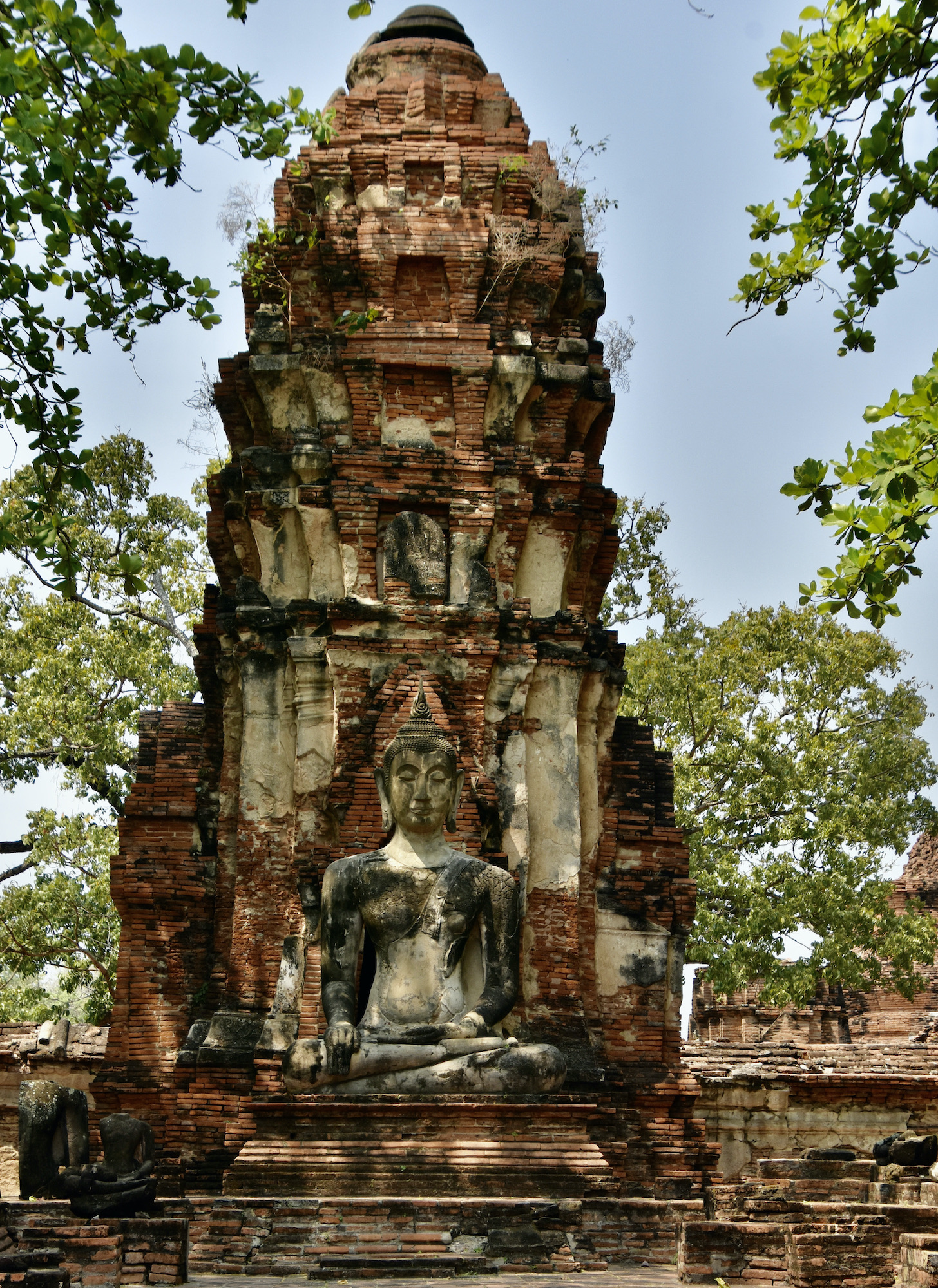
I mentioned that Wat Chaiwatthanaram was not in the Historic Park, but you can get a good look at the large temple from near the Octogan Pagoda. With the trees in full bloom, it’s a remarkable sight.
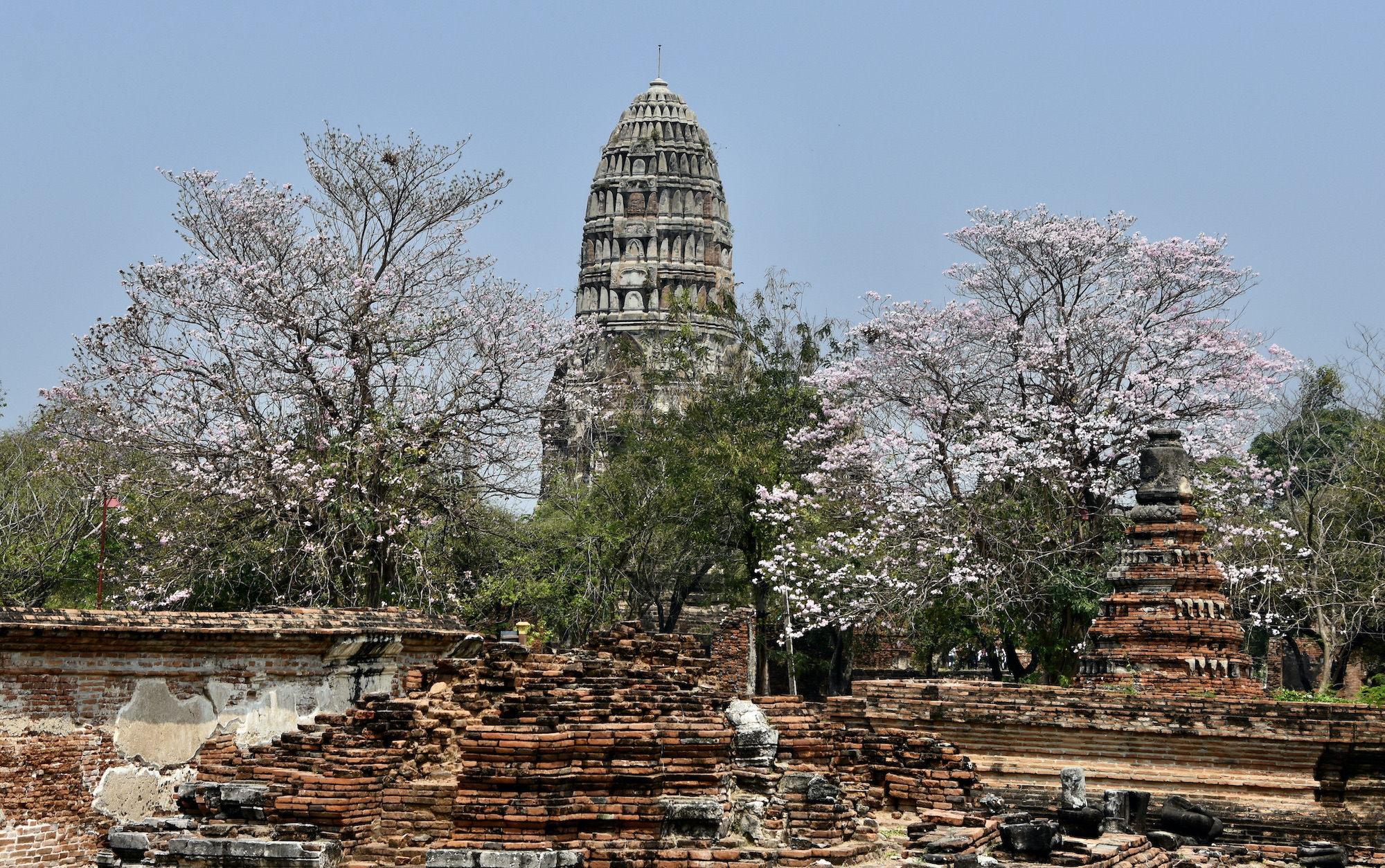
The ruins of the Grand Temple complex are pretty grim in the sense that everything is completely destroyed and probably the least interesting of all the places in Ayutthaya.
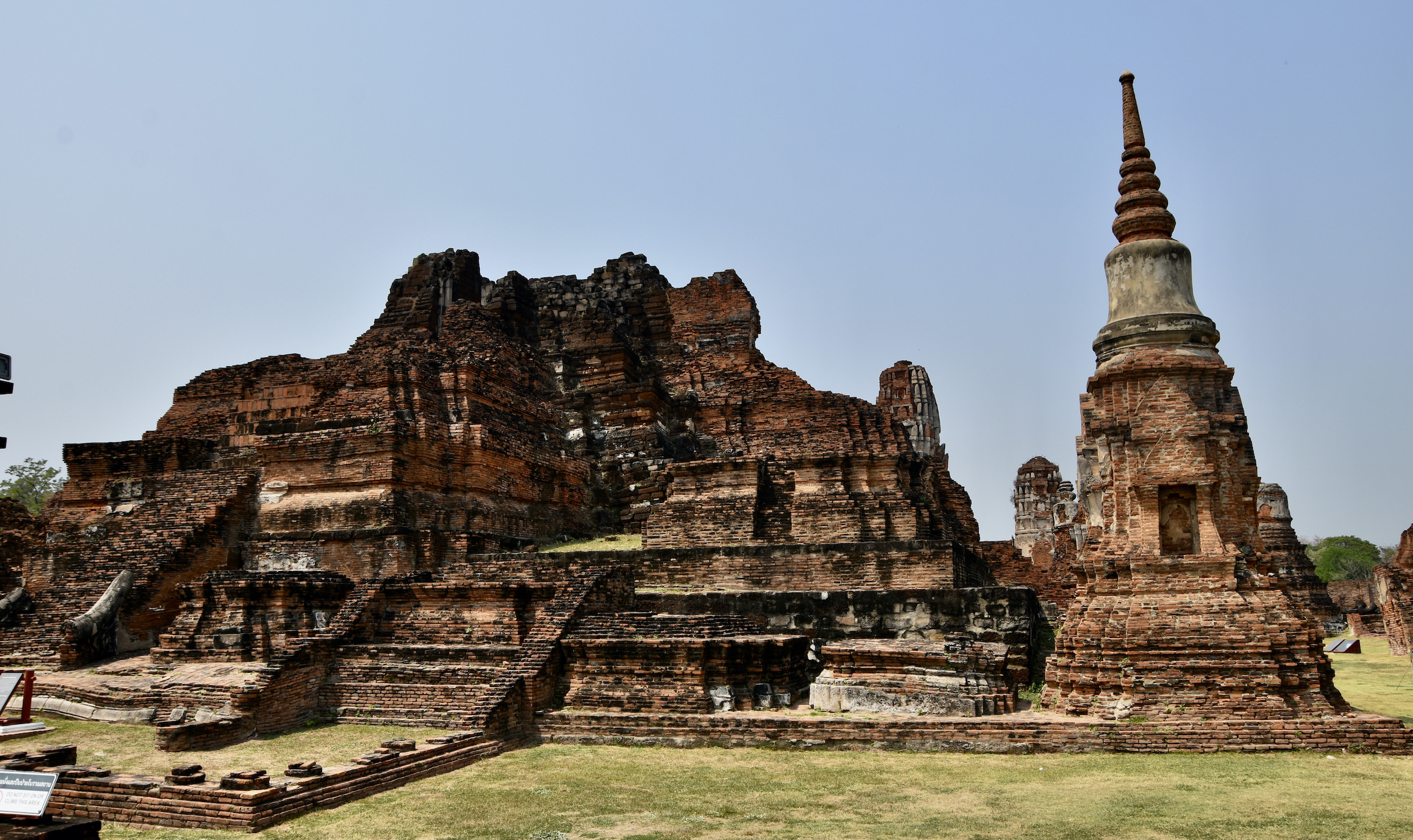
More interesting is this row of decapitated Buddhas. Removing the head of a Buddha statue was a sign of disrespect for the people who had just been conquered and that may very well have been what happened here. However, the Burmese were ousted quite quickly after they sacked Ayutthaya so it’s just as likely that the heads were removed by souvenir hunters and relic thieves because the heads show up everywhere around the world. It’s an incredibly insensitive thing to buy a looted Buddha head and use it as a garden prop or piece of home decor. Imagine the uproar if someone offered a decapitated head of a Jesus statue for sale? Sadly, we will be seeing a lot of this type of vandalism in the next few weeks.
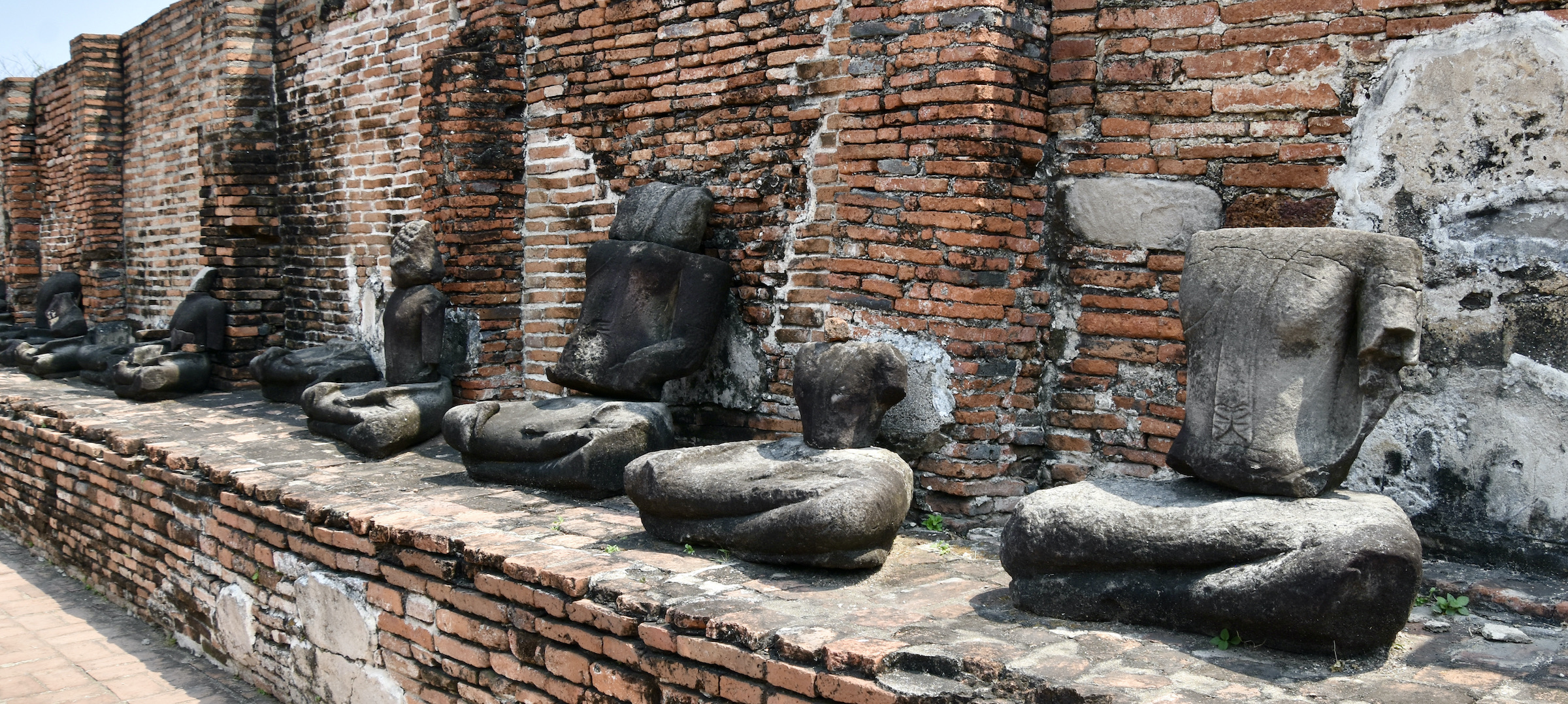
This probably the best preserved stupa in Ayutthaya and by examining it you can see how the red brick was covered in plaster which in turn was covered in gold or brightly painted. Stupas were built to house relics and come in various architectural styles. This one in the shape of a hand bell is considered Burmese, although it is found extensively throughout Thai Buddhist complexes and elsewhere.

My final photo from the on site visit to the ruins Ayutthaya is this one with two leaning Khmer style temples known as prangs.
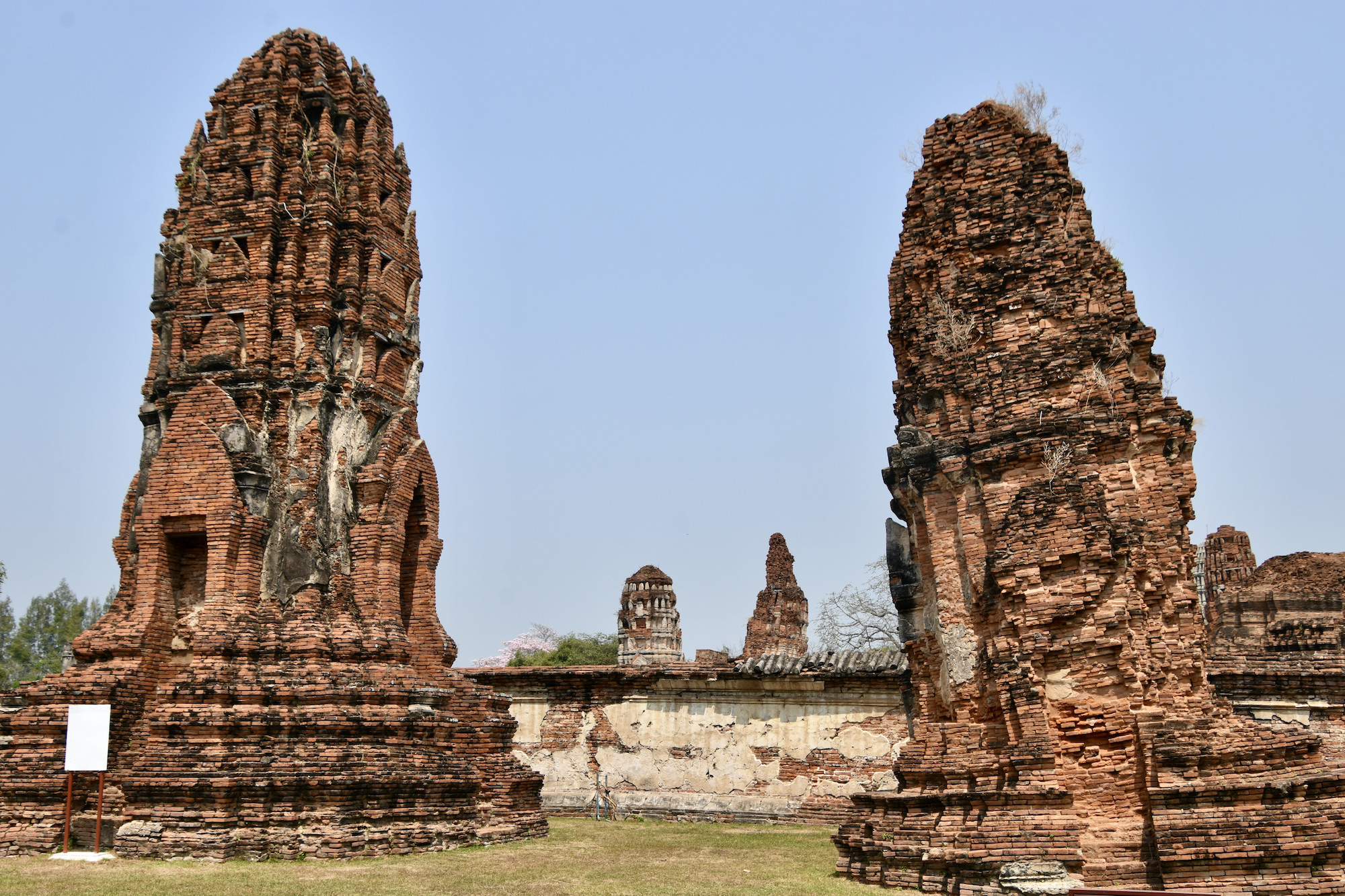
There is one building in Ayutthaya that remains in its original form, Wat Na Phra Men which was used by the Burmese army as its headquarters and thus spared. Just looking at it gives one a good idea of how magnificent Ayutthaya must have looked before it was destroyed.
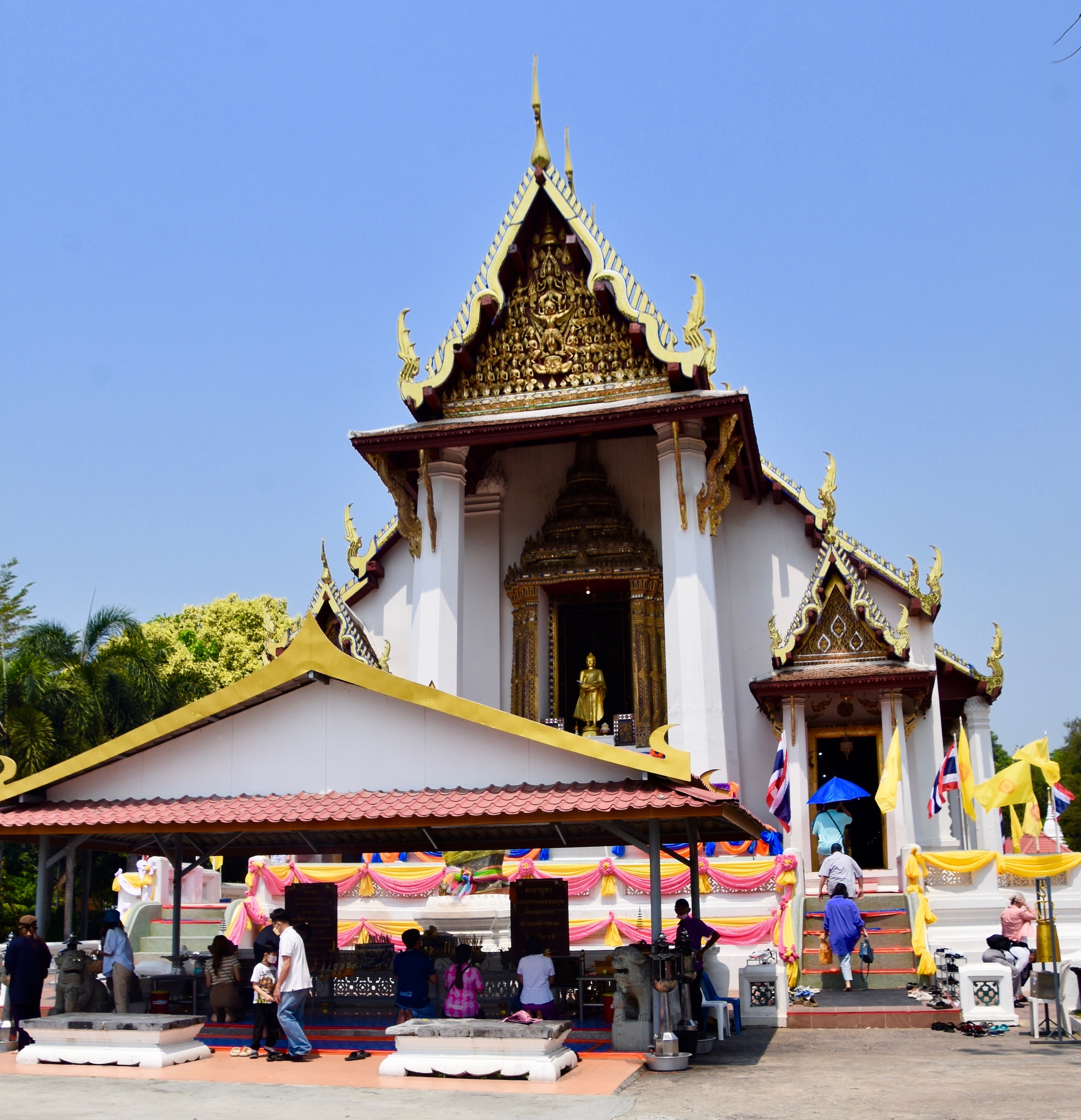
Inside there are two remarkable Buddha statues. This is the ‘Crowned Buddha’ which dates from the heyday of Ayutthaya in the 17th century. Made from cast metal and covered with gold leaf it is believed to have been created on the orders of King Prasat Thong who ruled from 1629-1656 and considered to be one of the great kings of Siam. Again, this one remaining temple interior from Ayutthaya gives a glimpse of the majesty of these buildings before their destruction.
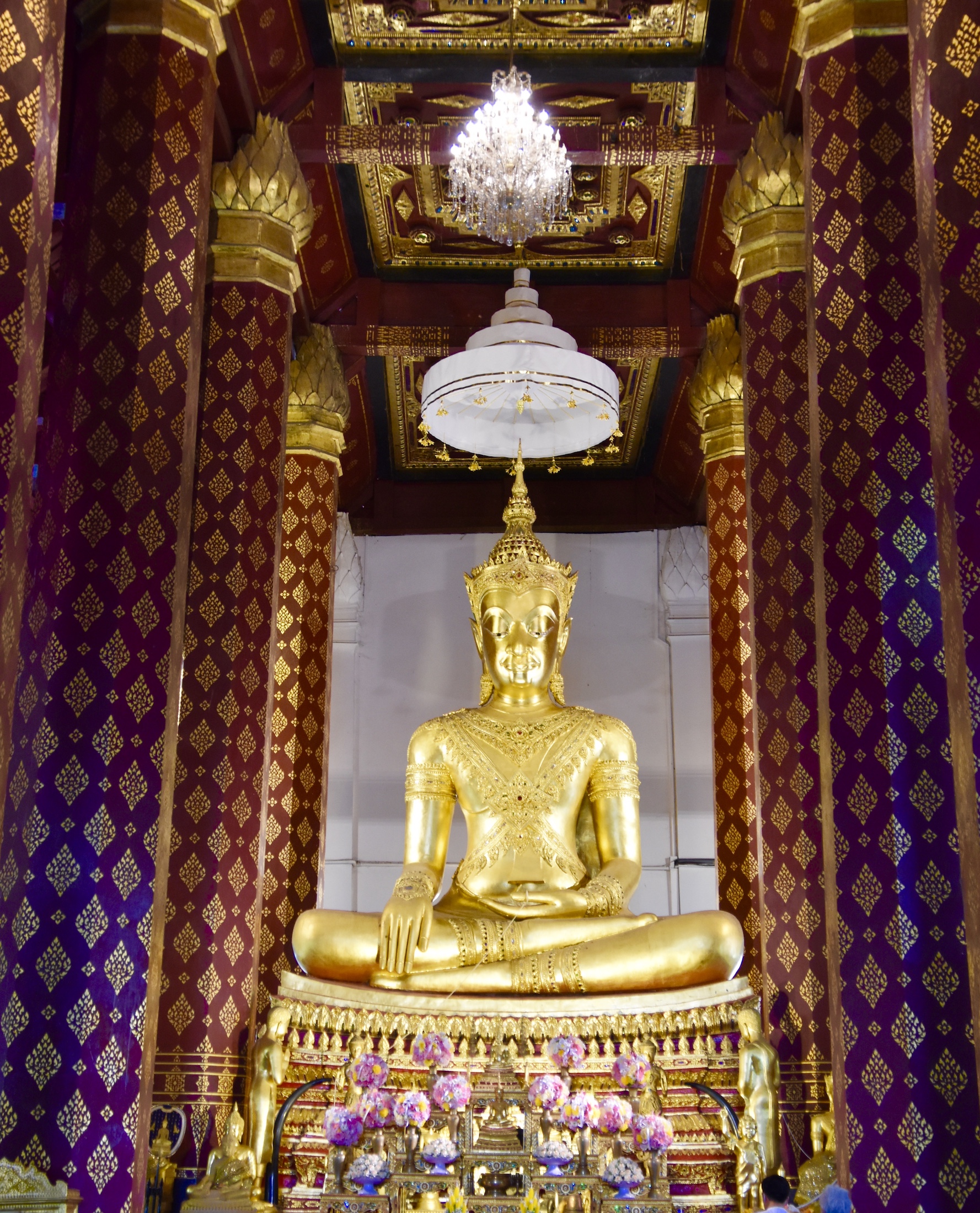
Almost a thousand years older than the Crowned Buddha is Phra Khantharat, a Buddha carved from a solid block of greenstone in India during the Gupta period when images of the Buddha were first becoming standardized. How and when it came to Ayutthaya is unknown. According to our guide Su it is the oldest Buddha statue in Thailand. With two hands on the knees and eyes closed this is a meditation Buddha, meant to acknowledge his enlightenment under the Bodhi tree in India.
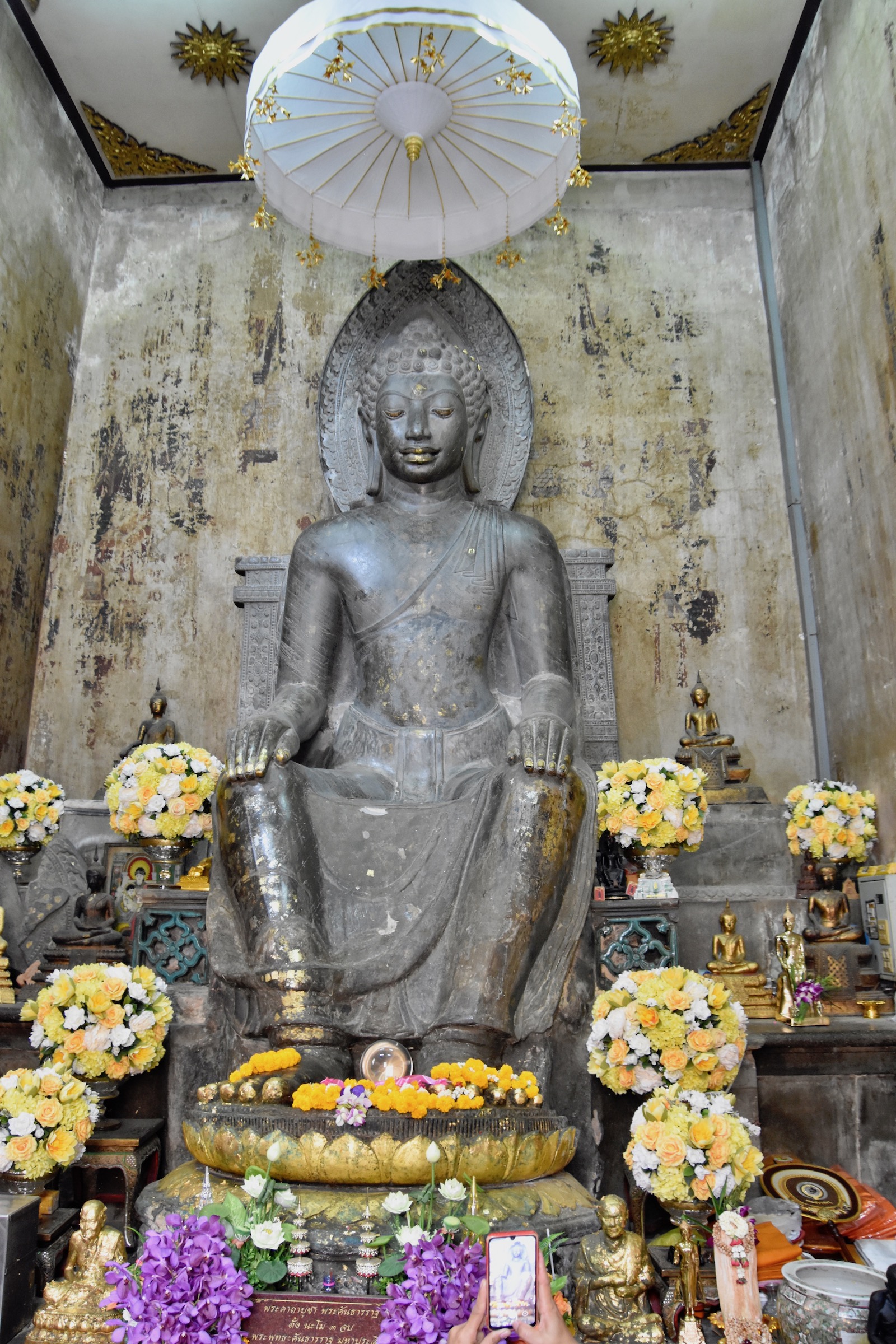
Su then leads us to a small room where a seated Buddhist monk blesses all comers by tying a small ribbon around a wrist. I am not a religious person. but I do not want to insult Su or the apparent sanctity of the place so we both get blessed. It certainly can’t hurt and who knows, maybe I’m wrong about religion and it will really work?
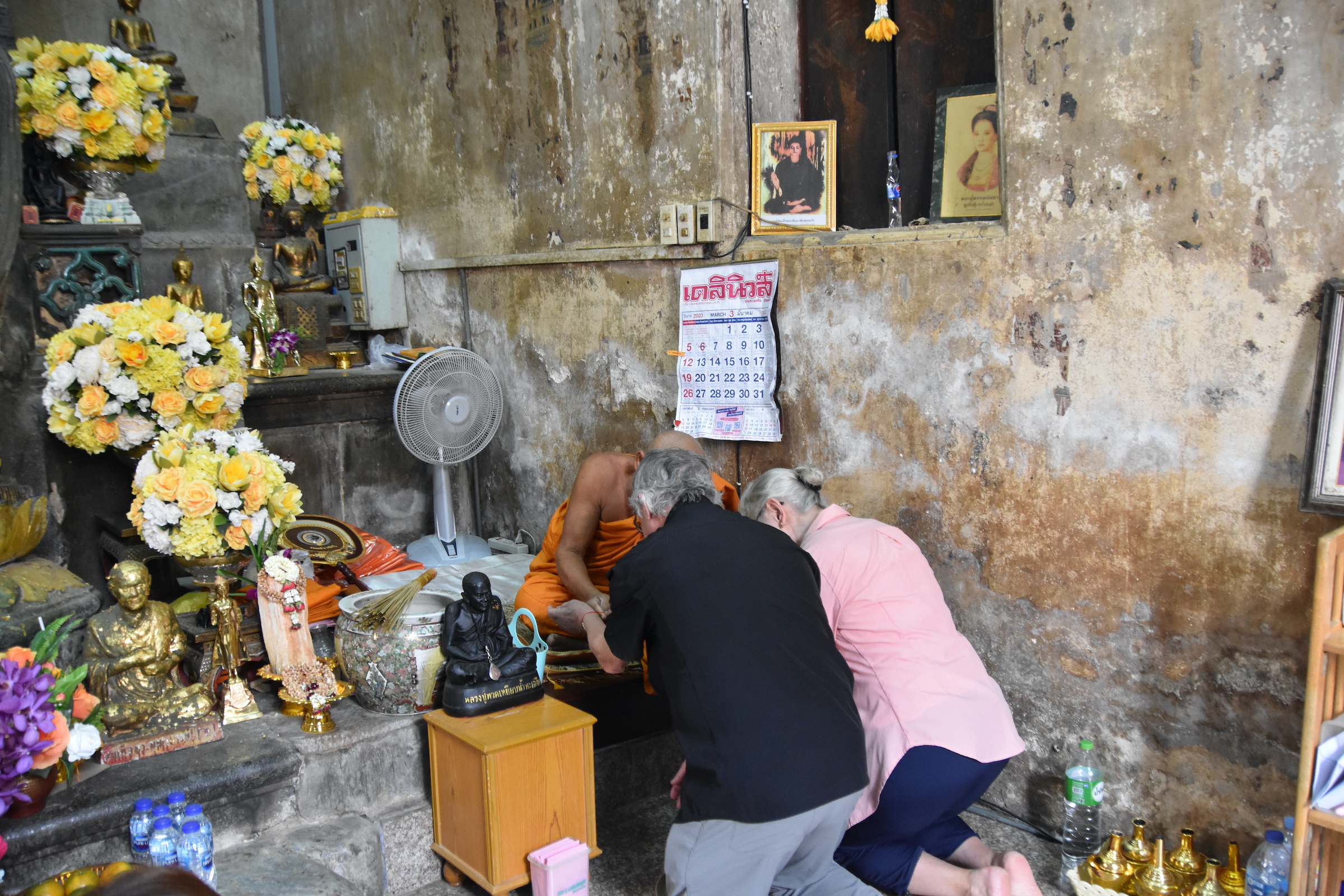
We have now concluded the land portion of this visit and we hop in the van for a short ride through the city of Ayutthaya to the riverfront where this boat awaits us on the Chao Phraya River.
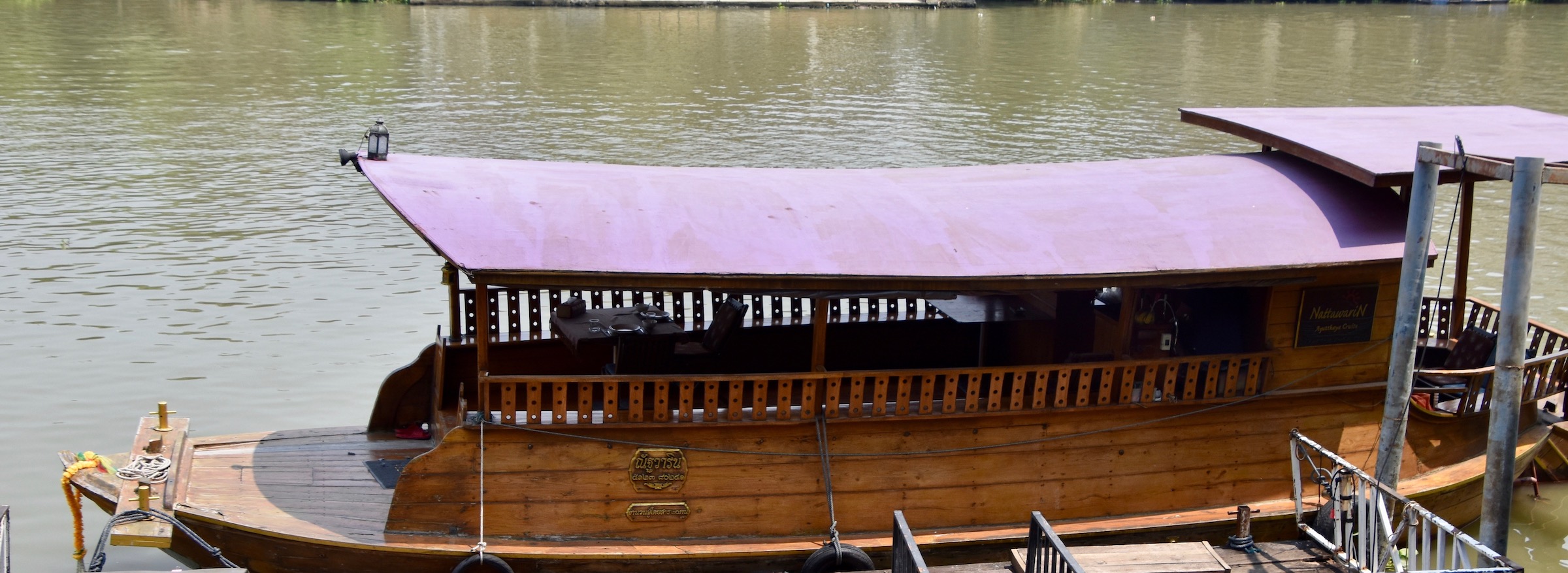
On board we dig into this luncheon spread as the captain pushes us off on what will be a 90 minute cruise on the river to view the ruins of Ayutthaya from a different perspective. I’m sure I don’t need to tell the reader that Thai cuisine is delicious and healthful and this lunch was no exception.
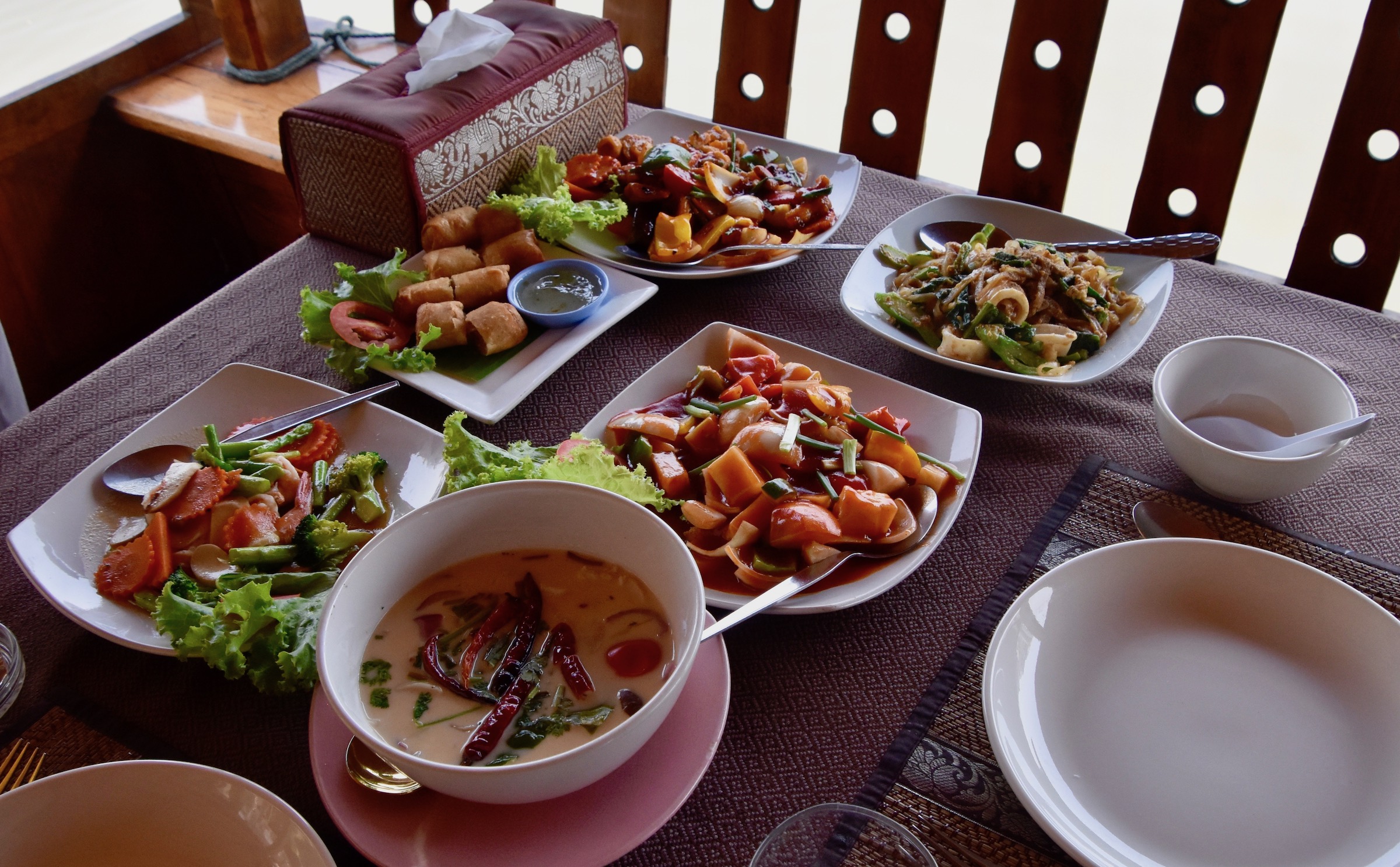
Not all the complexes on Ayutthaya island are ruins. Once you get away from the area included in the World Heritage Site there are complexes such as Wat Phanan Choeng.The building on the left in the photo below dates from 1324 even before the ‘official’ foundation of Ayutthaya.

There is also a temple decorated in a Chinese style.
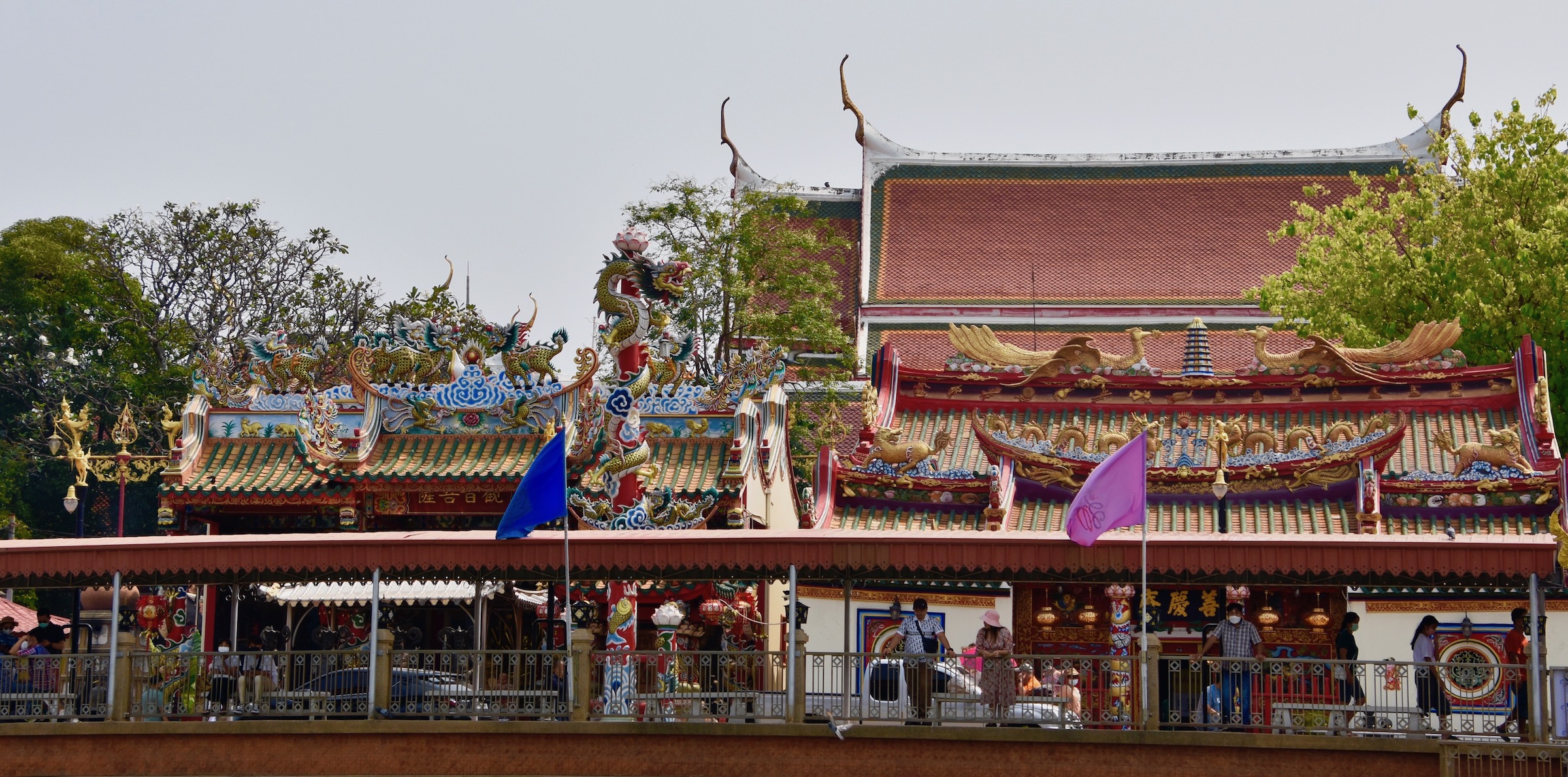
The most impressive site is definitely Wat Phutthaisawan which is on the opposite side of the river from Ayutthaya. Built in 1353 on a site that was intended to be the new capital until a plague wiped out most of the inhabitants, its gleaming white prang is another reminder of what the entirety of Ayutthaya must have looked like before its destruction.
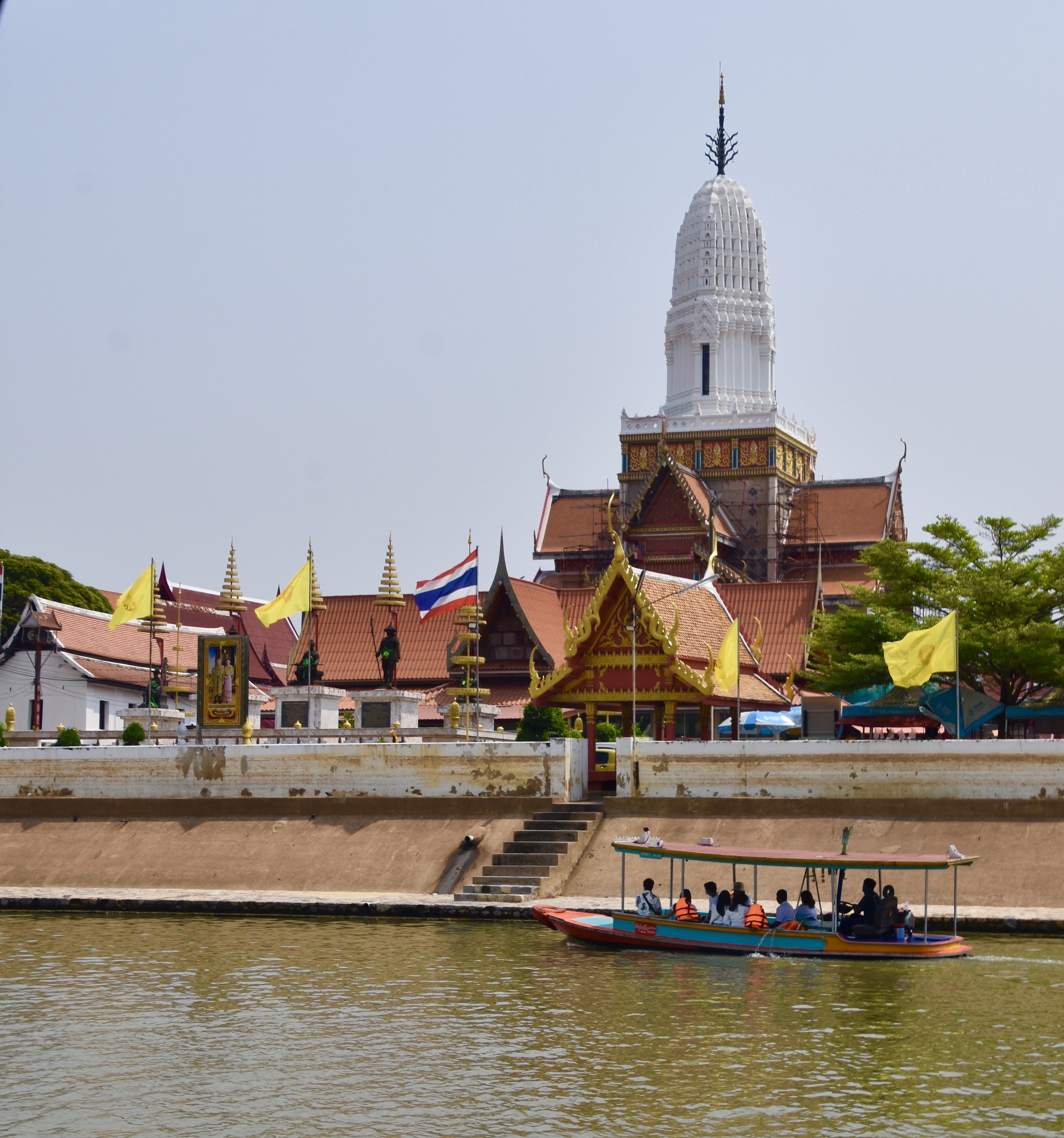
Temples dedicated to the Buddhist faith are not the only ones to be seen from the water. In fact all four major religions have a presence at Ayutthaya. This is St. Joseph Catholic Church which was built in 1666 by missionaries from Paris. It’s an imposing structure and a marked contrast to the other temples at Ayutthaya.
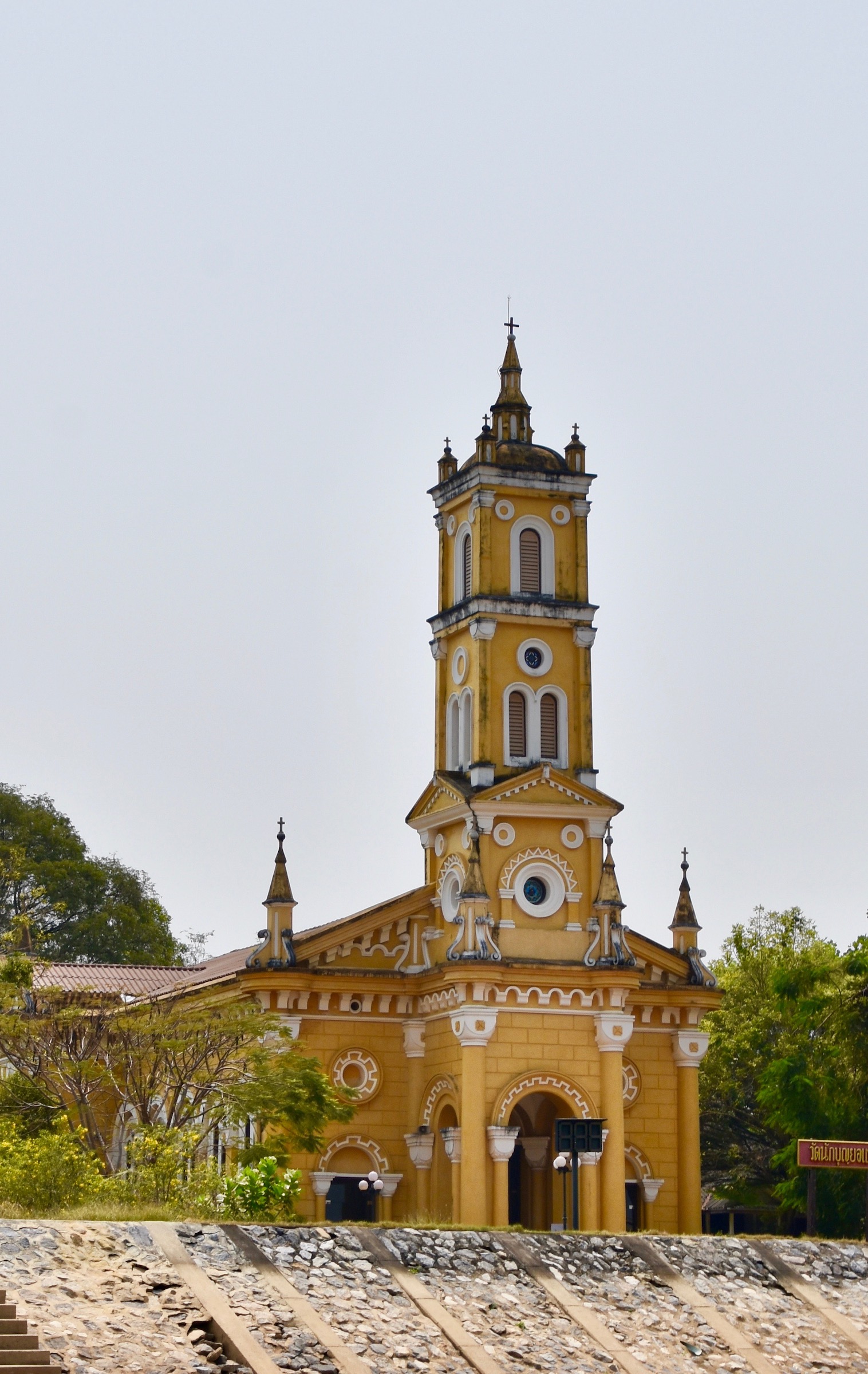
This is the first of many excursions on the water Alison and I will be taking in the coming weeks and I find they are always enlightening, particularly in seeing how the local people adapt to and live by and on the water courses. This was one of many traditional wooden houseboats we saw on the Chao Praya River today.
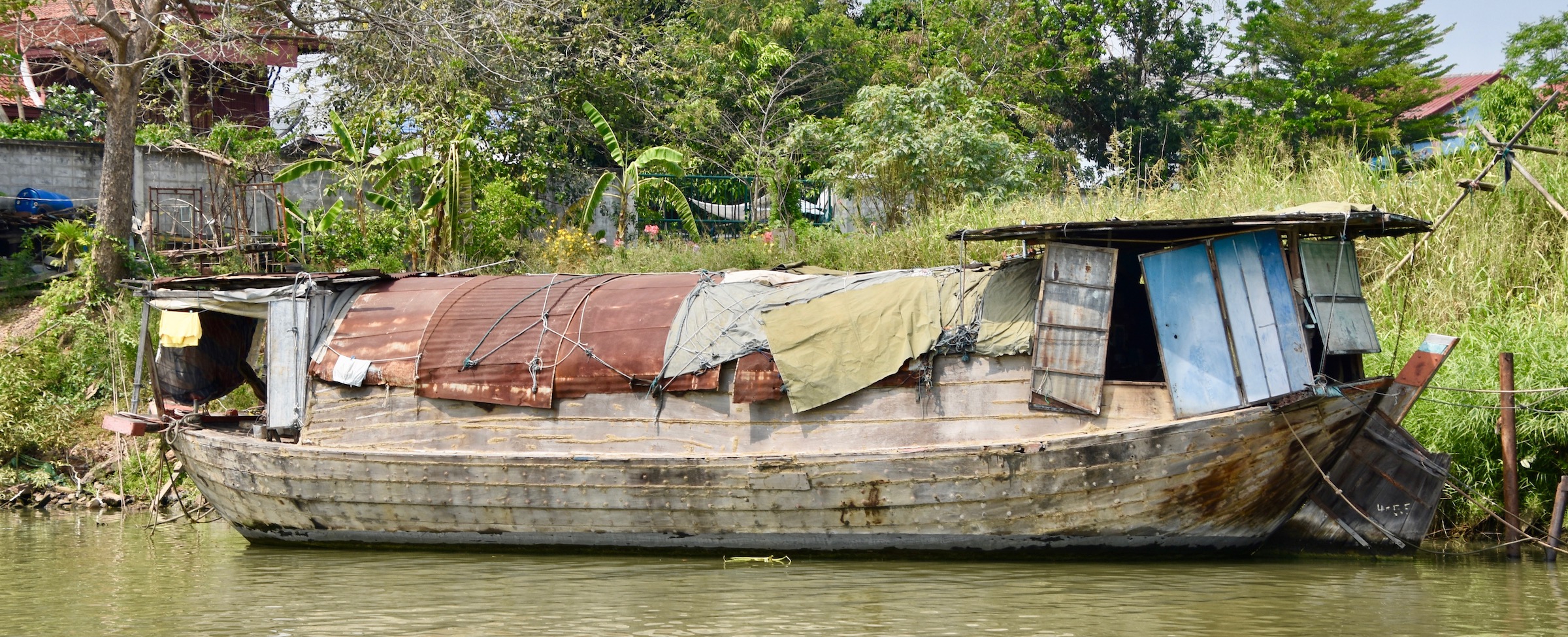
I also noticed people fishing in what seemed to be absurdly small boats that looked like they would flip over with the slightest of waves, but they didn’t as our wake just caused this guy to bob up and down like a cork.
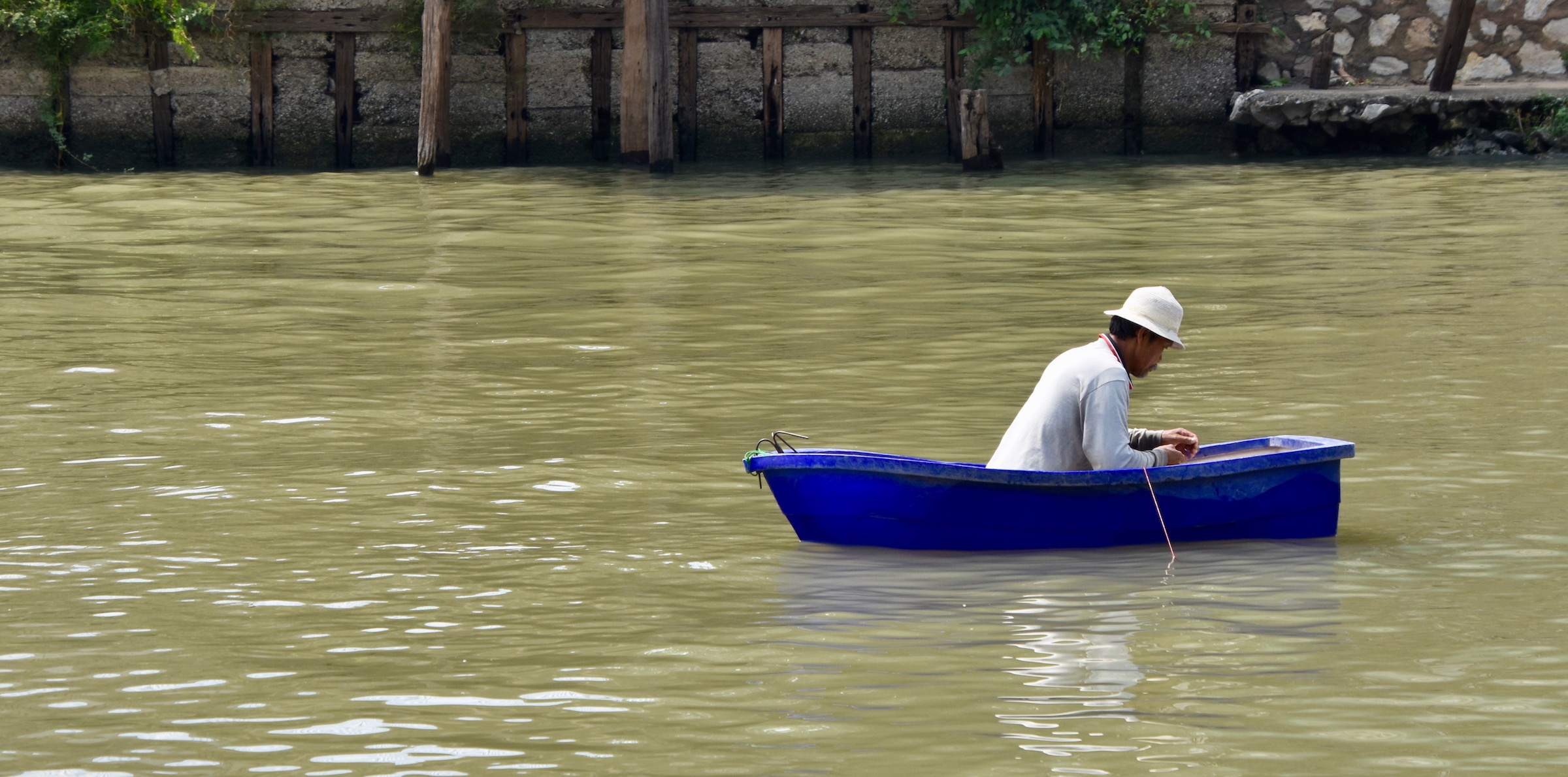
On the way back we pass by Wat Chaiwatthanaram once more and I realize we have seen only a tiny fraction of what there is to see at Ayutthaya.
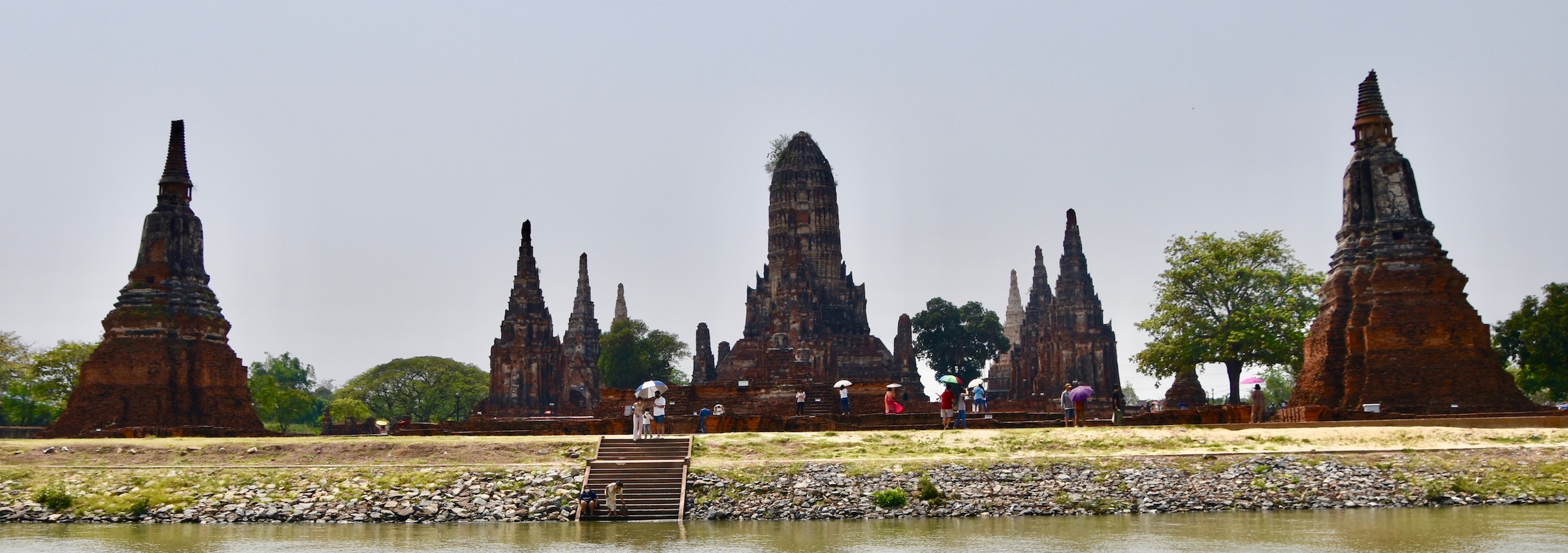
This is the final scene as we returned to our starting point, ending our visit to ancient Ayutthaya, but there is still more to see in this area.
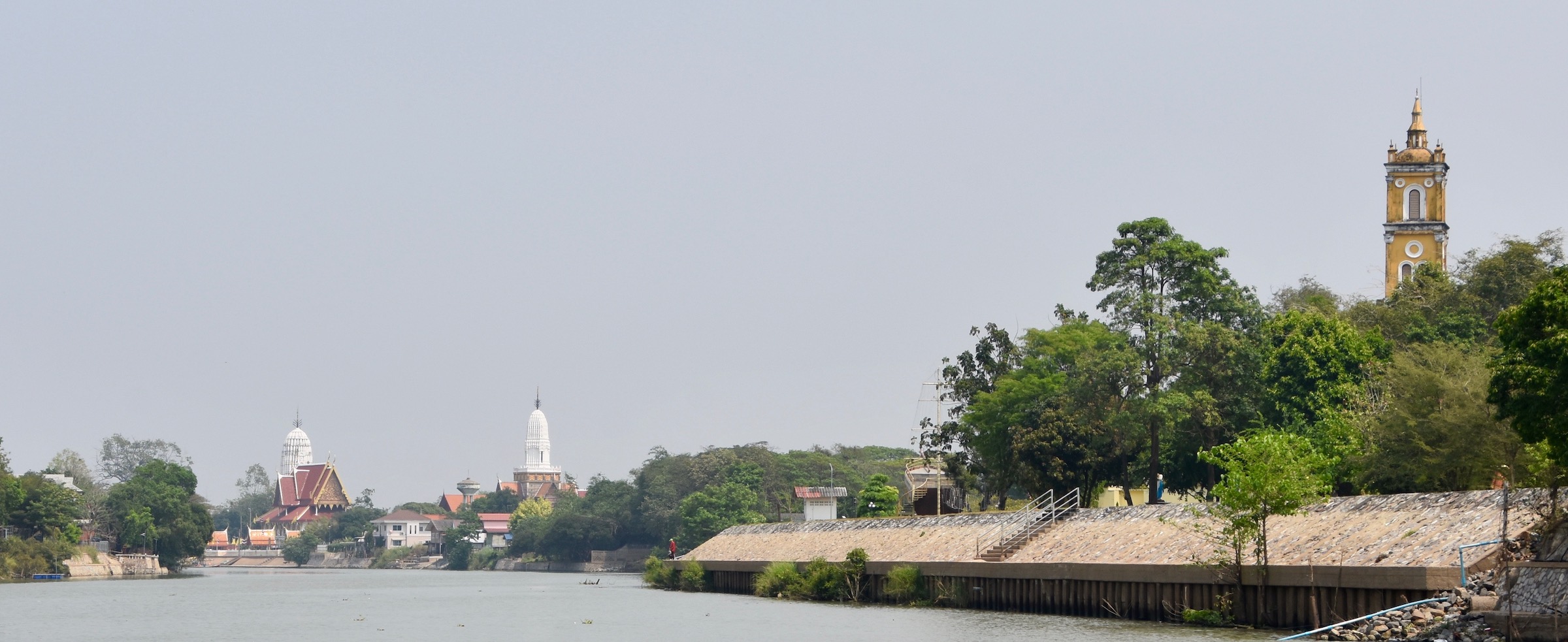
Bang Pa-in Summer Palace
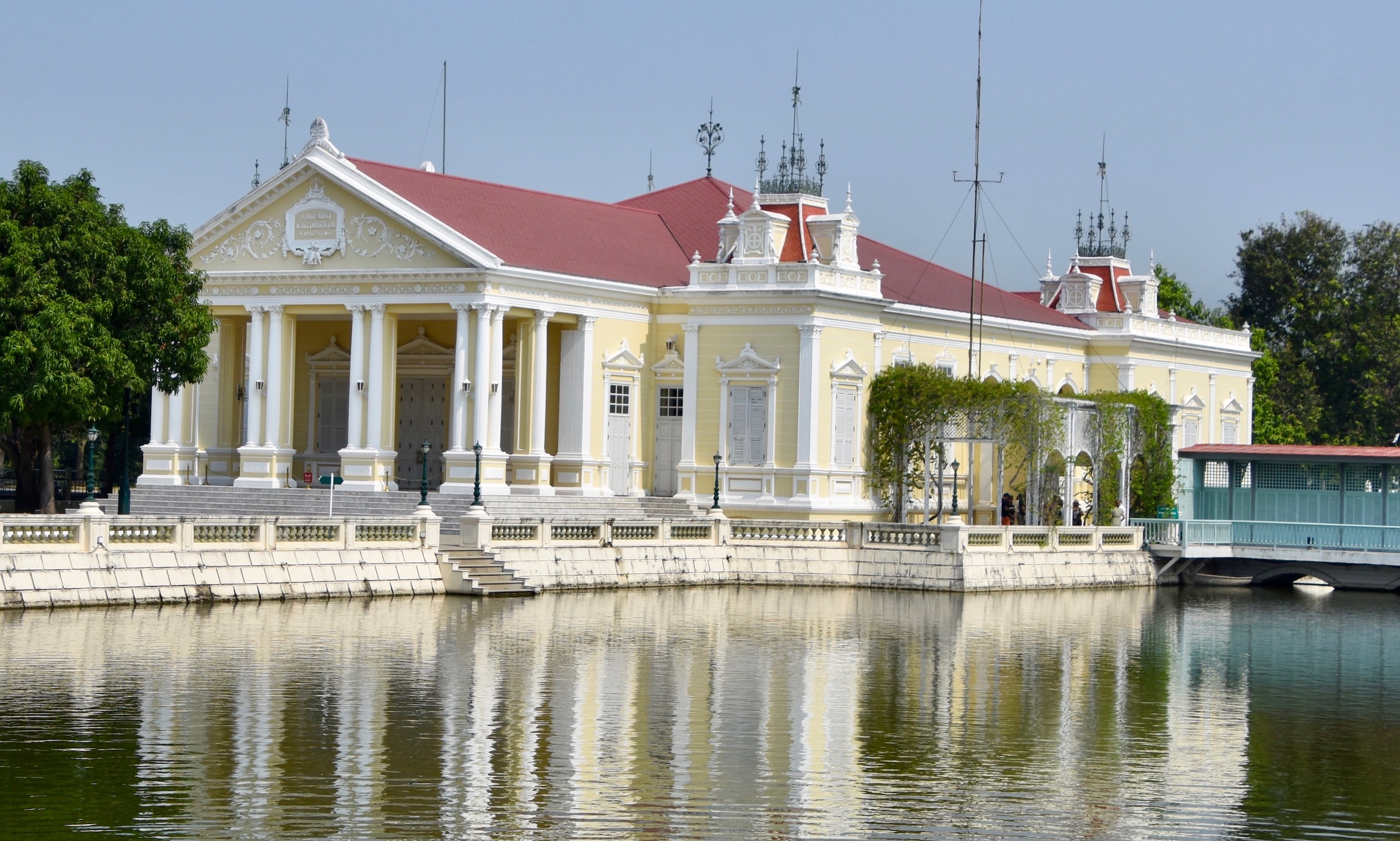
If you’ve taken the time and effort to leave Bangkok to visit Ayutthaya then you must include a stop at Bang Pa-in, the summer palace of the Thai kings and still in use today.
Although there have been structures here that date back to the glory days of Ayutthaya, most of what is on this royal site a few miles away from the island dates from the mid-19th century and later. King Rama IV, who is the known in the west for his portrayal in Anna and the King of Siam and the musical The King and I, decided to revive the place and build a new palace there. However, it was Rama V who was responsible for the international style of architecture that is heavily influenced by classical western themes, including the actual Summer Palace shown above.
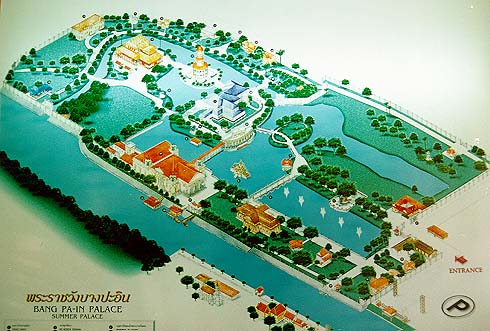
This is a map of the Summer Palace complex grounds which features a number of buildings in contrasting styles built around the sides of an artificial lake. There is no set manner in which to see the place, but most tourists go to the left from the entrance and follow the course of the lake in a clockwise direction which is what we will do.
The first thing we notice is not a building, but rather a number of huge turtles feeding on something I couldn’t identify, but the turtles seemed to love. Buddhists have a custom that if one releases a turtle it will lead to long life and every year hundreds of thousands of turtles are ‘liberated’ into the Chao Phraya River and almost certain death because of the polluted state of the waterway. This practice combined with the insatiable appetite of the Chinese for turtle meat has put dozens of Asian species on the road to extinction. Read this article, Asia’s Turtle Tragedy for more details. It’s a sickening story and these few turtles at Bang Pa-in have no idea how lucky they are.
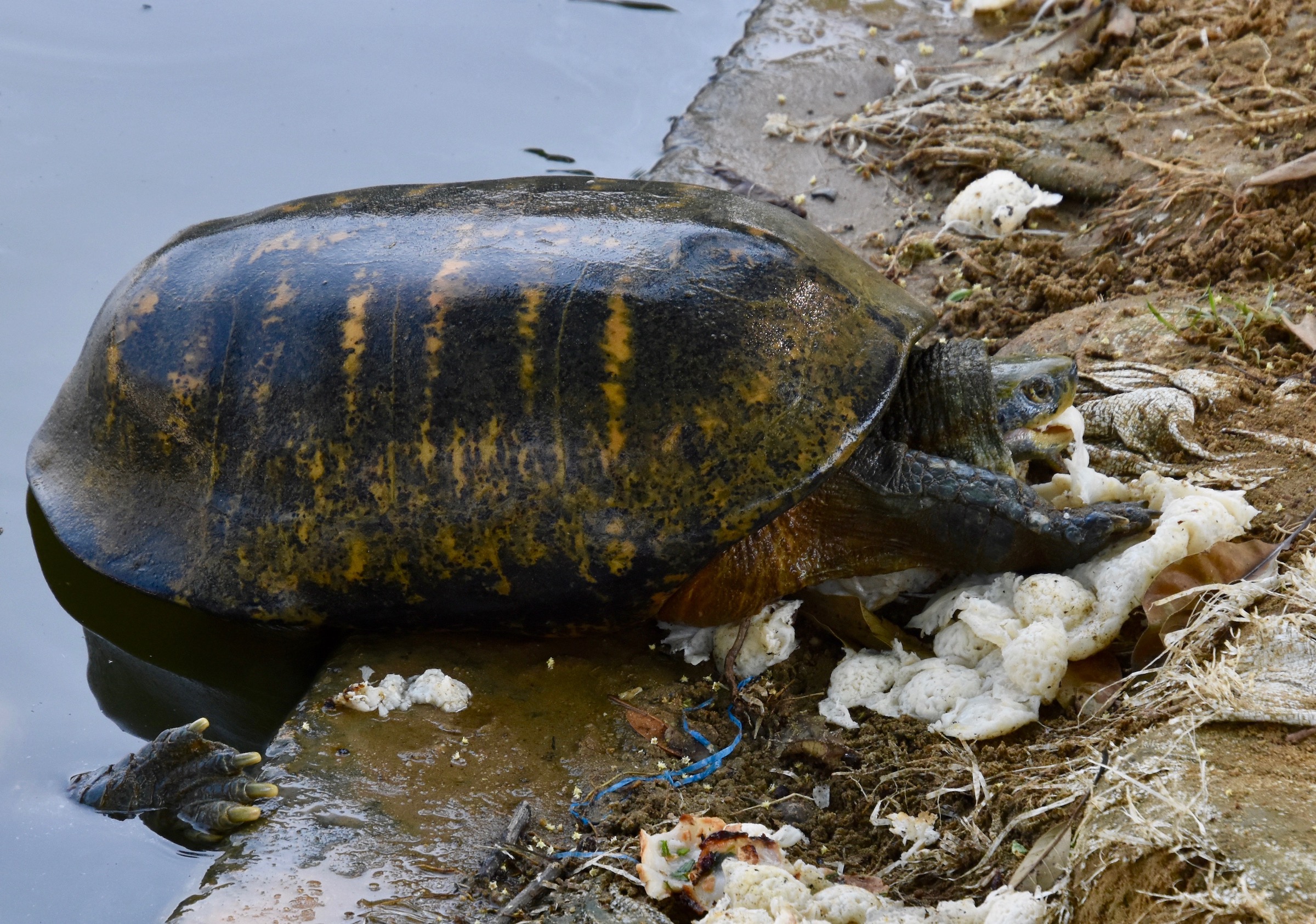
The first building you might notice at Bang Pa-in is across the river on a small island and definitely seems out of place. What is a Christian church doing in this location? Except it’s not a Christian church but rather Wat Niwet Thamprawat, a Buddhist temple built by Rama V in neo-Gothic style, the only one of its kind in Thailand. You an actually take a free ferry over to the island to visit it, but we didn’t have time.
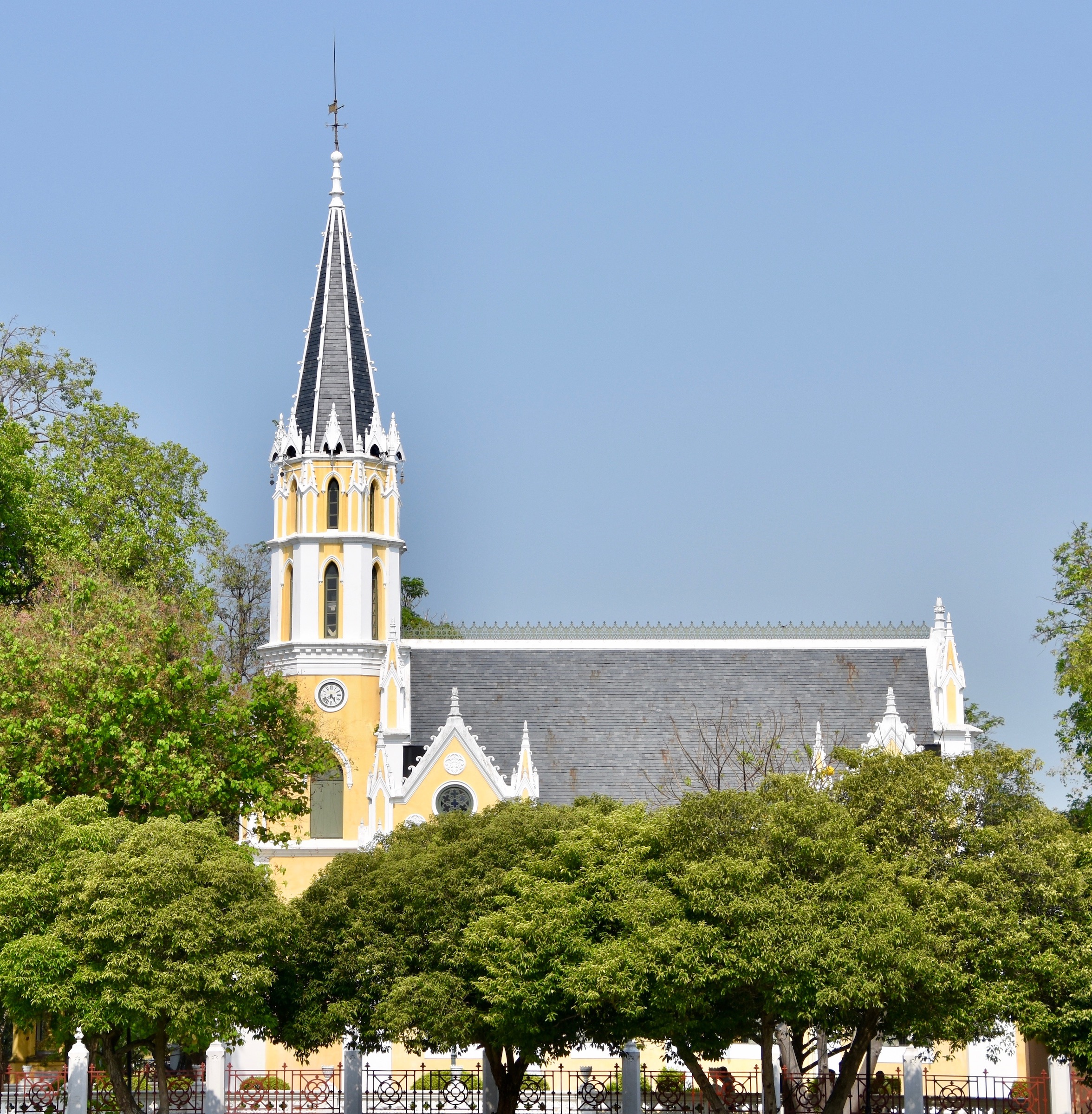
The next building of interest is the Summer Palace which you cannot enter. It is connected by this covered walkway to the Consort’s Palace where the king’s favourite concubine of the time would be housed. She would make her way to the palace when beckoned, but shielded from the eyes of any curious onlookers.
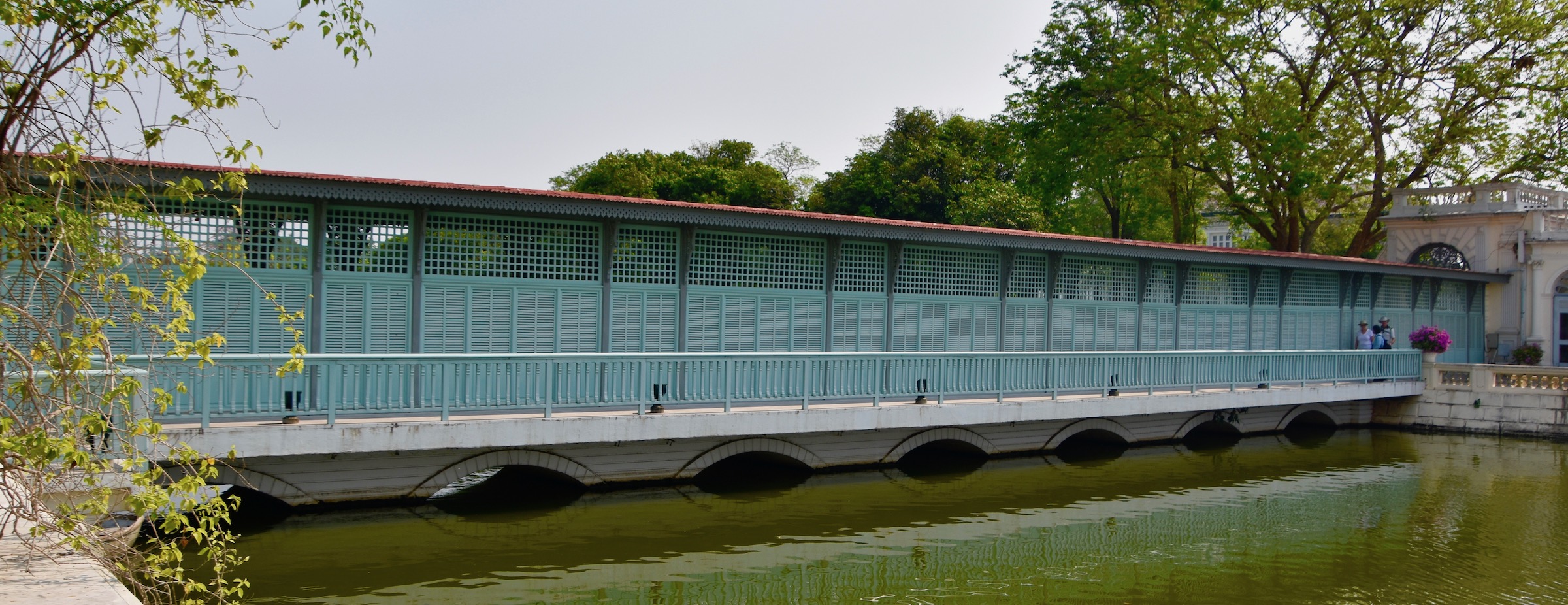
The European look of the Summer Palace and its grounds is really brought home by the so-called ‘Doll’s Bridge’ which looks like it belongs at Versailles than Ayutthaya, aligned as it is with statues of classical Greek figures.
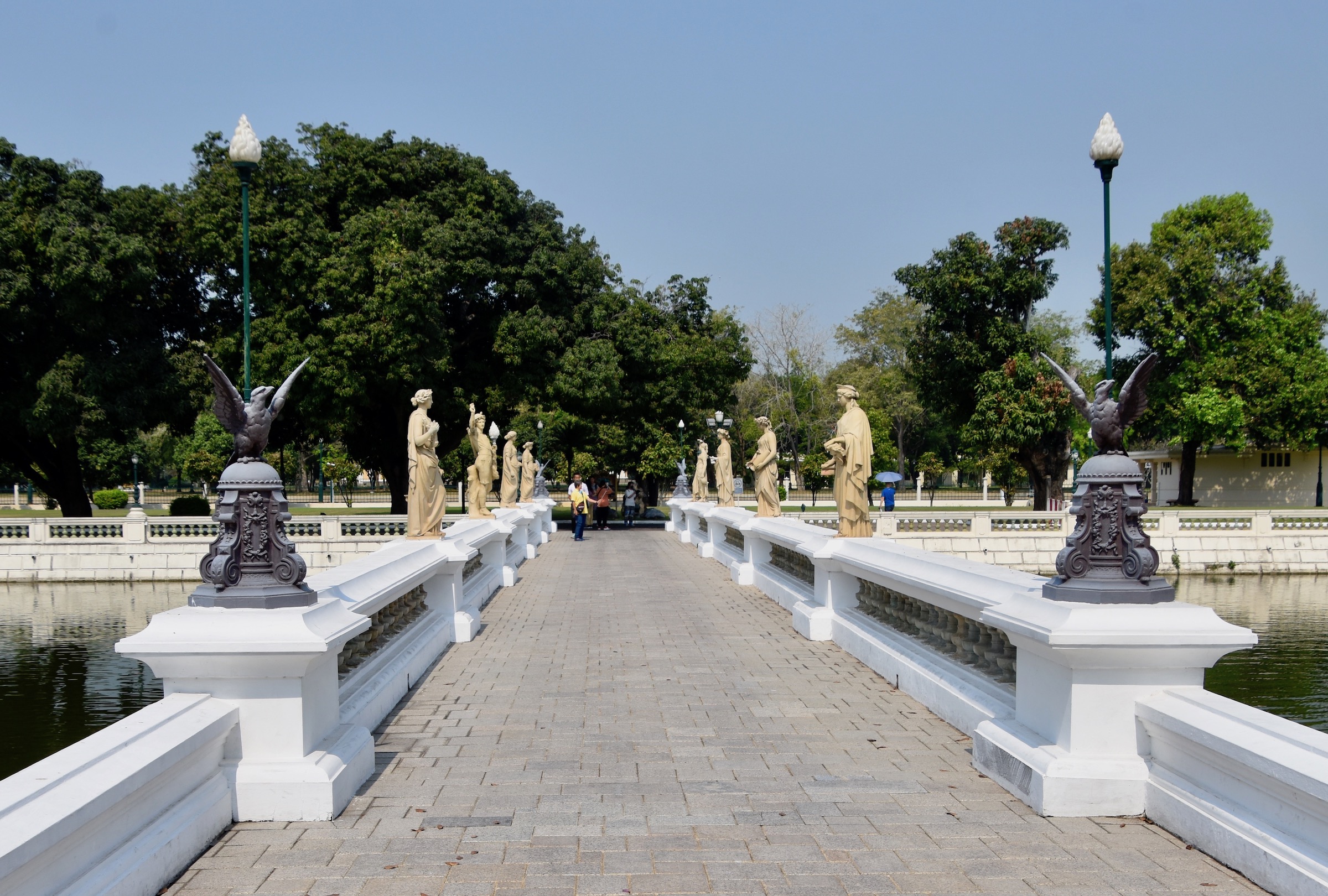
Near this bridge is a monument to a tragedy that occurred nearby in 1880 when Queen Sunanda Kumariratana and her daughter drowned when the royal barge they were using to get to Bang Pa-in collided with another boat and they were thrown overboard. She was the daughter of Rama IV and first wife of Rama V who was devastated by her death and that of his daughter.
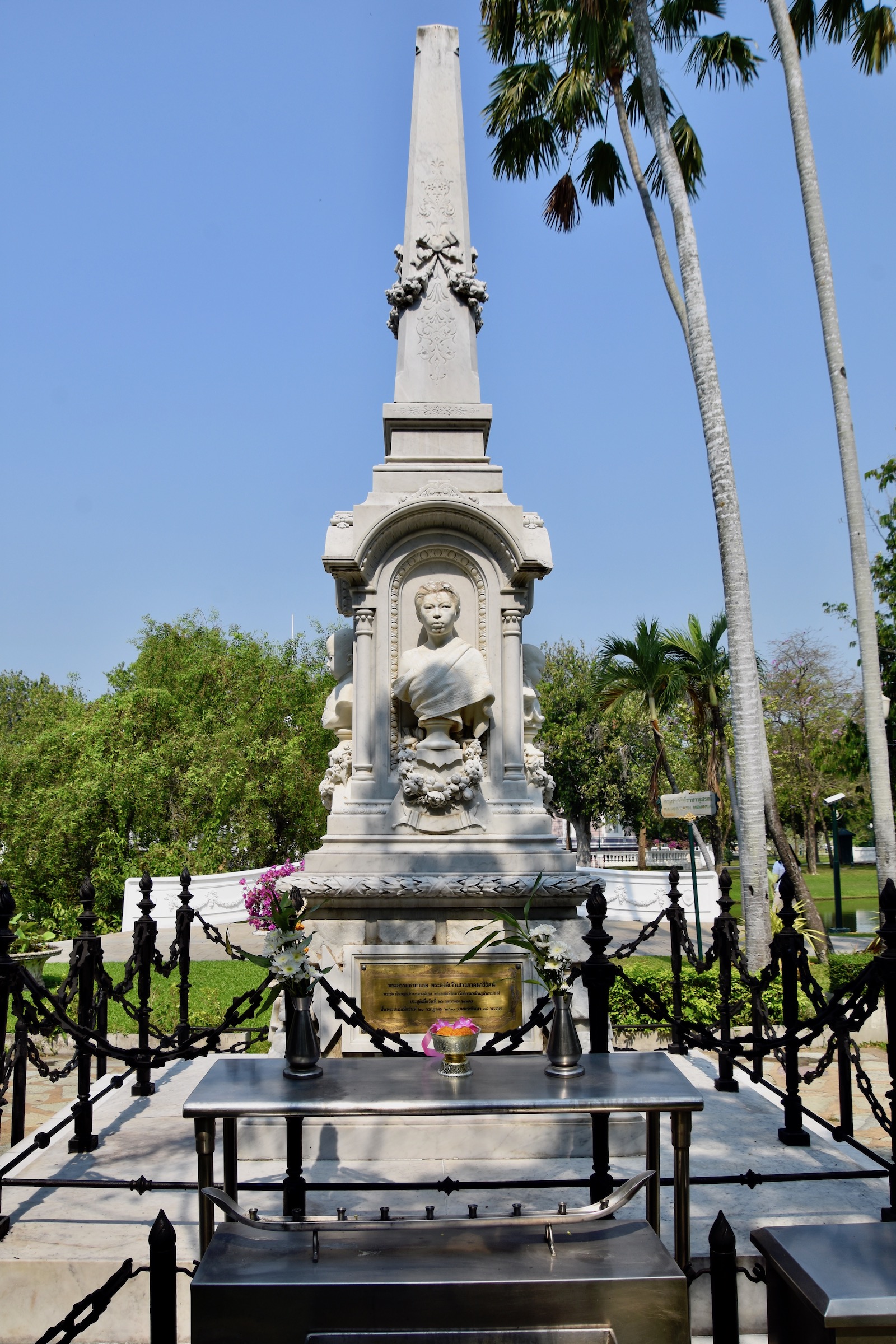
Not all the building at Bang Pa-in reflect western influence. This is Wehart Chamrun built in Chinese style and a gift to King Rama V from the Chinese Chamber of Commerce in Thailand. The tall building is an observation tower known as the Sage’s Lookout. It dates from 1881. Together the two buildings make for the best place to get your picture taken in the Summer Palace complex.
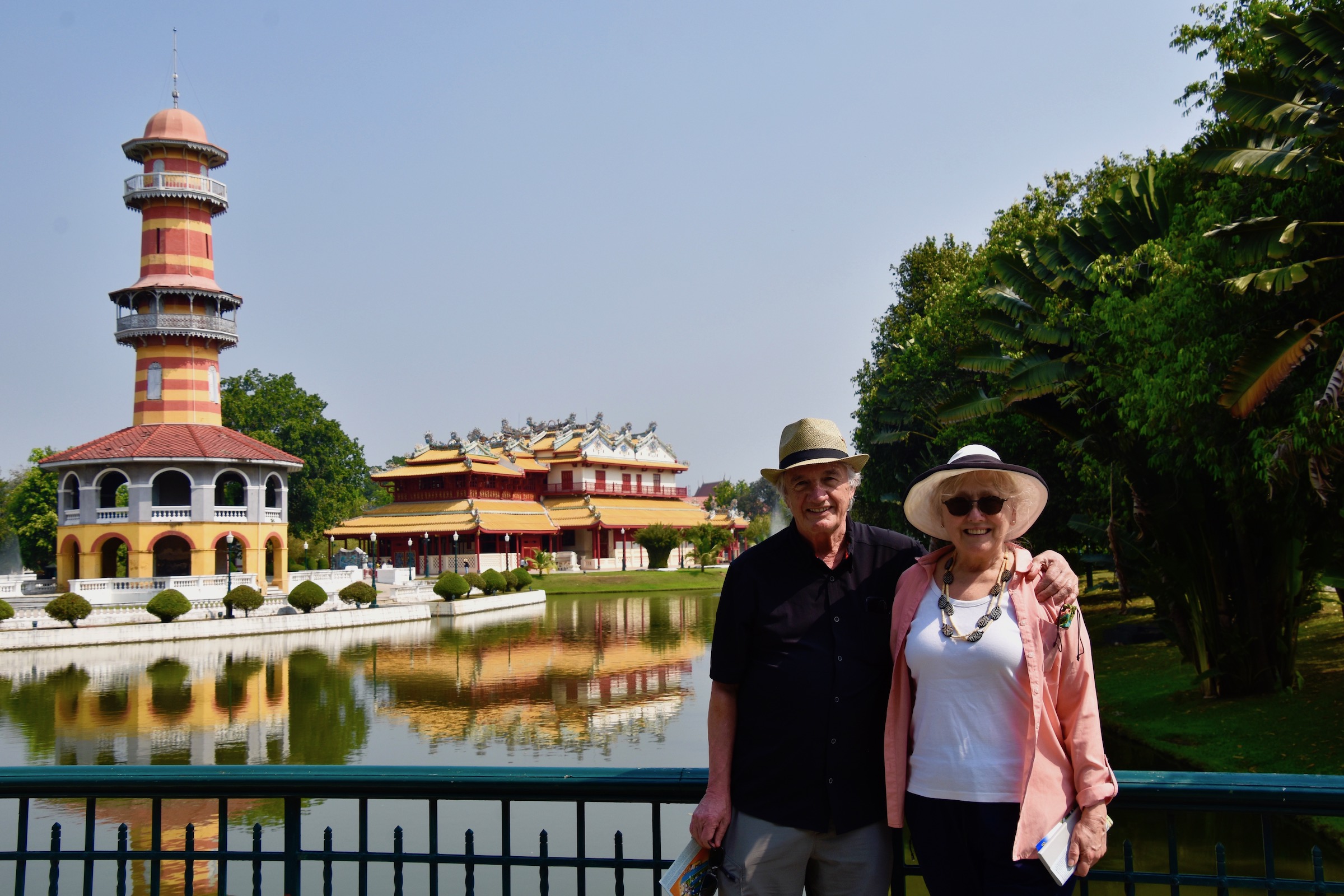
There are other buildings and monuments of note in Bang Pa-in, but this post from Ayutthaya is already long enough so I’ll sign off.
In the next and final post from Thailand we will visit two more important temples in Bangkok.

